The Baguette
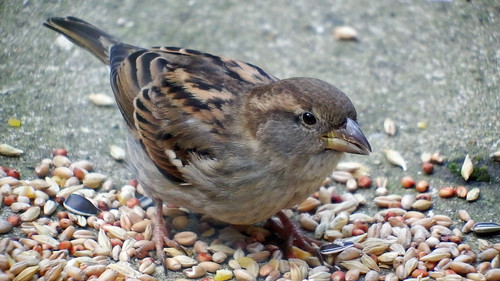
After visiting the Juno Beach Centre in Courseulles-sur-Mer, I drove to the town of Fontaine-Henry near Caen to take a tour of its most famous residence, the Château de Fontaine-Henry. The name of the town means "fountain of Henry" the old spelling of the name Henri, a possible reference to Henry de Tilly.
The town was also known for it fountains and preponderance of wells, one of which can be seen just in front of the main doorway. Château de Fontaine-Henry has belonged to the same family for nearly ten centuries without ever having been sold. Nevertheless, several names have succeeded in ownership because it has repeatedly been handed down by women. The families Tilly, d’Harcourt, de Morais, Boutier de Château d'Assy, de Montécler, de Marguerie, de Carbonnel, de Cornulier and d’Oilliamson have all come into ownership through inheritance. 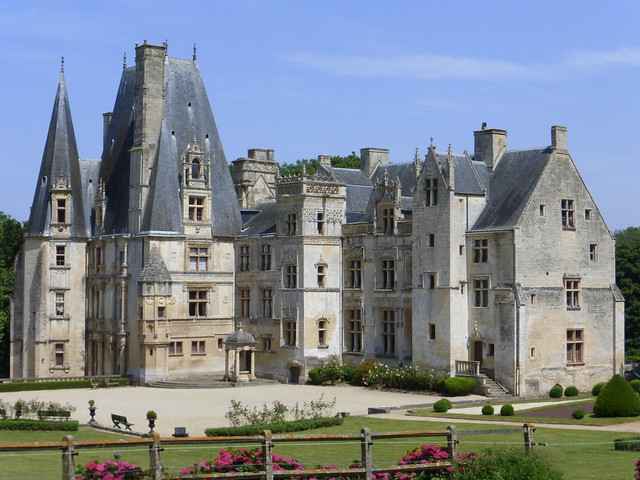 There was a fortress at this location at the beginning of the 11th century and the Tilly family replaced the old fortress between 1200 and 1220 with a new castle. All that survives from this period are the chapel and vaulted rooms that once formed the ground floor of the residential building. These two elements give a measure of the magnitude and importance of this château in the middle ages. In 1374 Jeanne de Tilly married Philippe d'Harcourt and brought him a dowry of a lordship or 'seigneurie'.
There was a fortress at this location at the beginning of the 11th century and the Tilly family replaced the old fortress between 1200 and 1220 with a new castle. All that survives from this period are the chapel and vaulted rooms that once formed the ground floor of the residential building. These two elements give a measure of the magnitude and importance of this château in the middle ages. In 1374 Jeanne de Tilly married Philippe d'Harcourt and brought him a dowry of a lordship or 'seigneurie'. 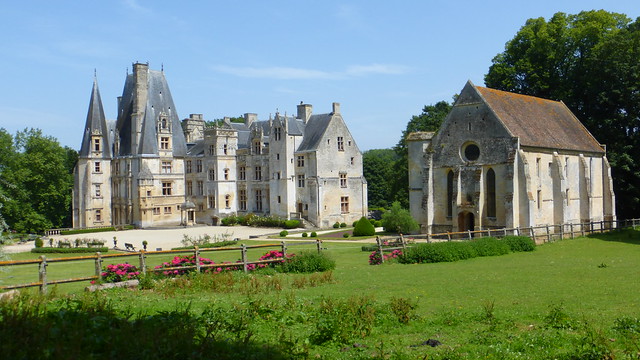 It was the Harcourt family who began to rebuild the château after the Hundred Years War. The works were spread out over nearly a century, from the late 15th century to the 1560s. The château is still lived in by the descendents of its early owners, the comte and comtesse de Olliamson. The château has a very original kind of architectural harmony, making it a Renaissance masterpiece, following the examples of the Hôtel d'Escoville and the Hôtel de Than in Caen. On its west façade one can see the different styles of architecture used during its evolution--the west side being the most curious where there are a series of three levels of columns.
It was the Harcourt family who began to rebuild the château after the Hundred Years War. The works were spread out over nearly a century, from the late 15th century to the 1560s. The château is still lived in by the descendents of its early owners, the comte and comtesse de Olliamson. The château has a very original kind of architectural harmony, making it a Renaissance masterpiece, following the examples of the Hôtel d'Escoville and the Hôtel de Than in Caen. On its west façade one can see the different styles of architecture used during its evolution--the west side being the most curious where there are a series of three levels of columns. 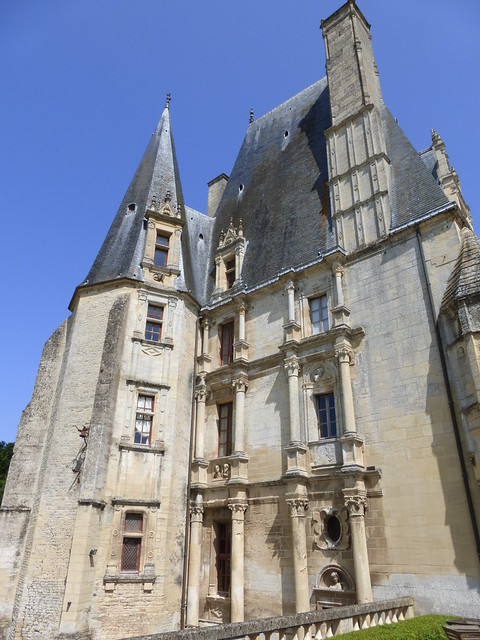 This was done to create perspective and the illusion of height.
This was done to create perspective and the illusion of height. 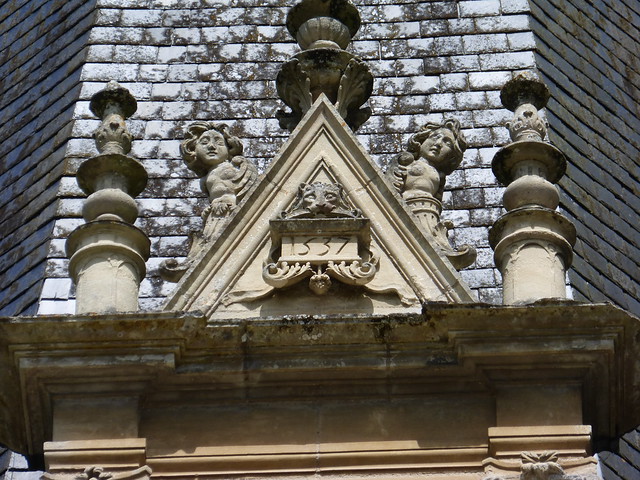 Above one of the windows is an inscription dated precisely to 1537, the date of completion for this portion of the château.
Above one of the windows is an inscription dated precisely to 1537, the date of completion for this portion of the château. 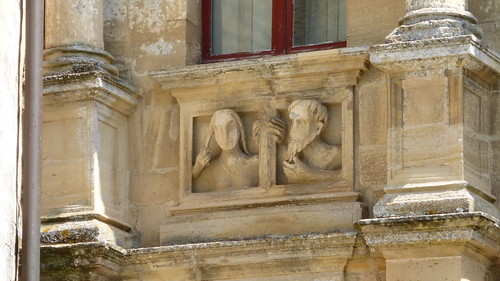
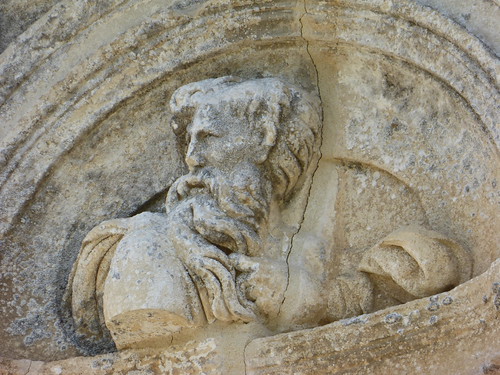
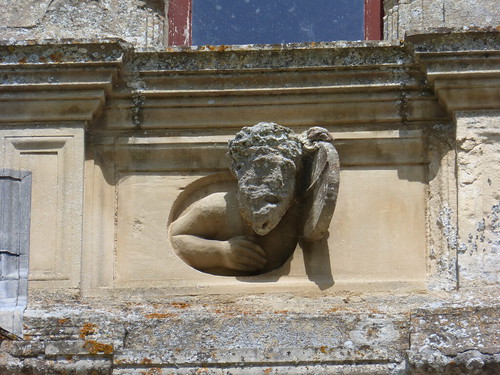 There are several Biblical features on this façade as well, the images of Adam and Eve, Moses and Noah.
There are several Biblical features on this façade as well, the images of Adam and Eve, Moses and Noah. 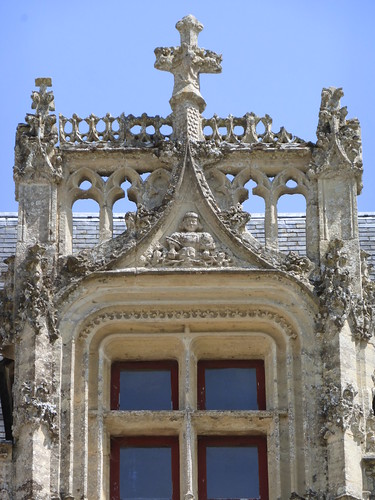 Above another window is the image of Charles VIII. I was most impressed by the quantity and quality of the stonework with its filigree patterns and decorative medallions.
Above another window is the image of Charles VIII. I was most impressed by the quantity and quality of the stonework with its filigree patterns and decorative medallions.
The details are amazing if you take the opportunity to study them—especially around the lower windows which have images of cherubs, birds and plant motifs. 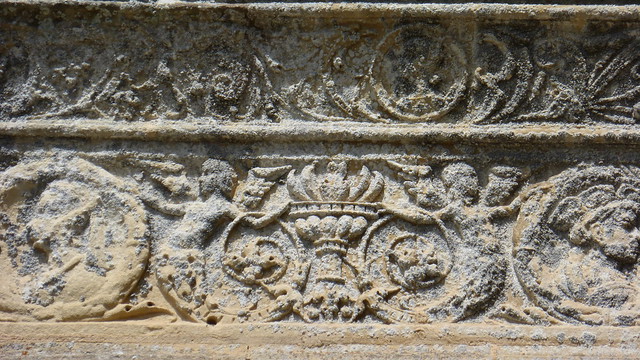
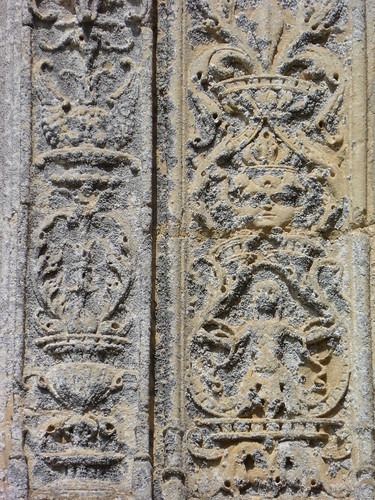
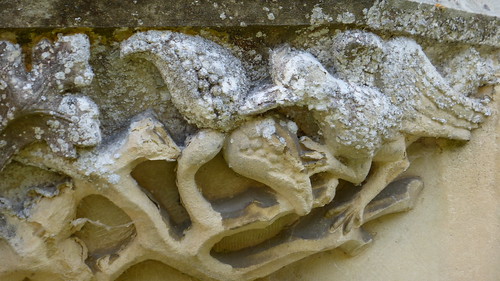 The château is more than 15 meters high and the roofs that cover the building are considered to be the highest in France.
The château is more than 15 meters high and the roofs that cover the building are considered to be the highest in France. 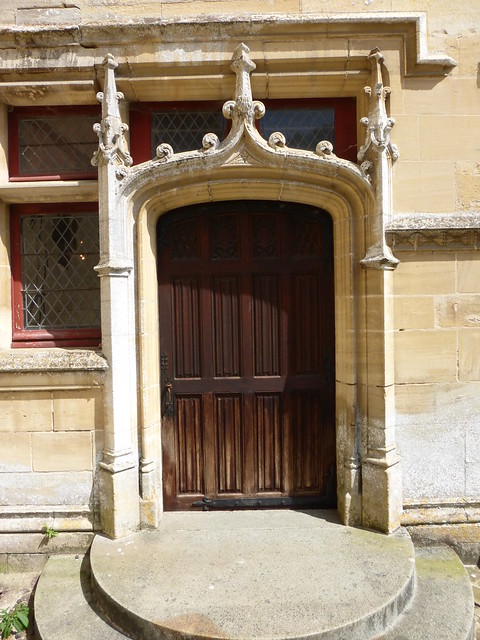
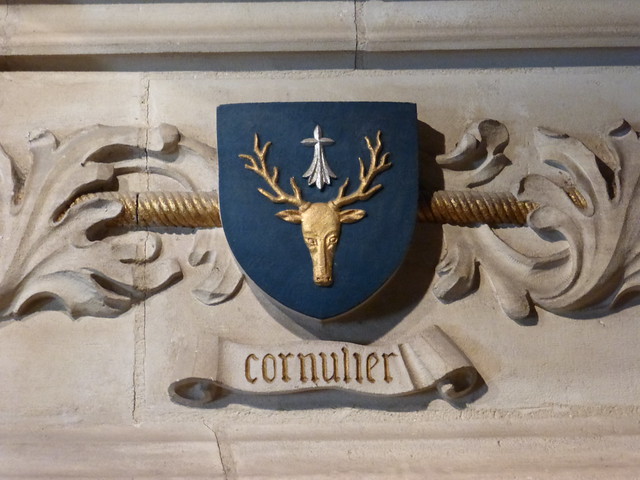
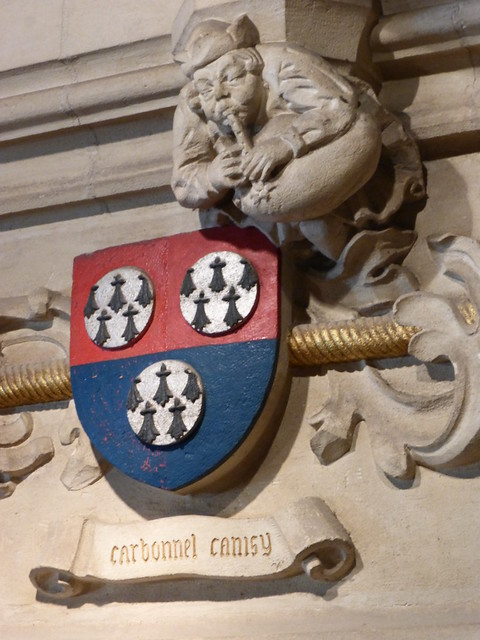

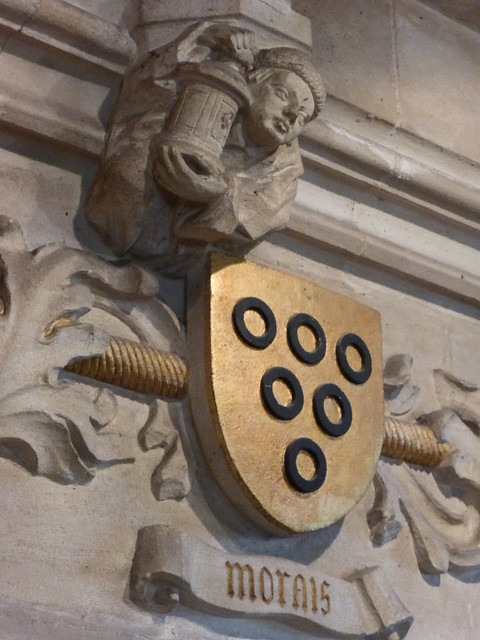 We weren’t allowed to take any photos inside except for in the main reception hall which used to be the kitchen. Here there are three large fireplaces. Above them are the coats of arms of the different families who have owned the house over the centuries. The chapel was founded in the 13th century and transformed in the 16th century.
We weren’t allowed to take any photos inside except for in the main reception hall which used to be the kitchen. Here there are three large fireplaces. Above them are the coats of arms of the different families who have owned the house over the centuries. The chapel was founded in the 13th century and transformed in the 16th century. 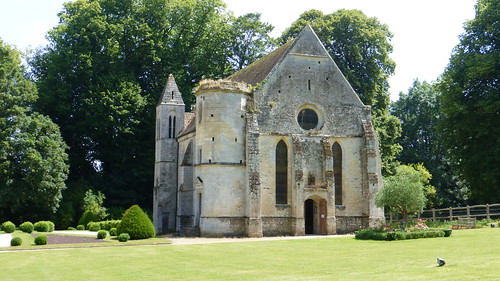
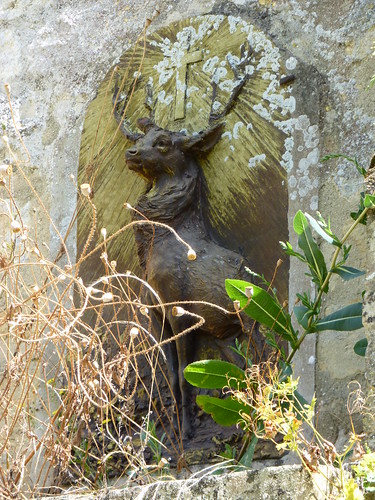 There is an image of a stag just above the main doorway which I think represents the fondness of hunting by one of the former owners who is it said killed 1000 stags in his lifetime. Good for him ?
There is an image of a stag just above the main doorway which I think represents the fondness of hunting by one of the former owners who is it said killed 1000 stags in his lifetime. Good for him ? 
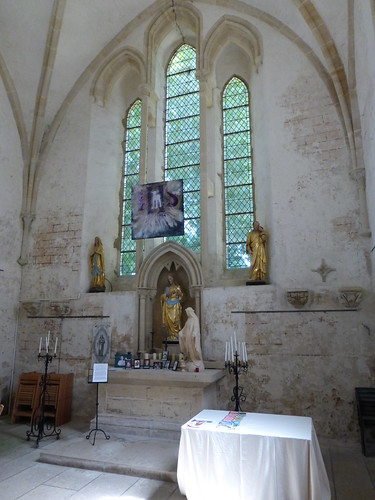
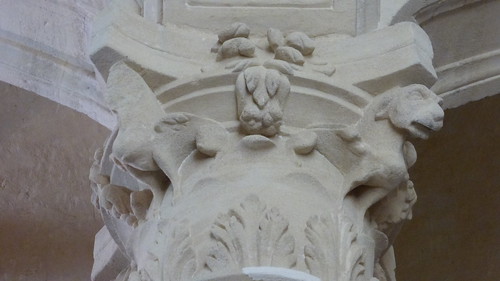 Gothic arches are featured along the sides and decorative capitals above the columns. It is open to the public and has an exhibition of religious art inside.
Gothic arches are featured along the sides and decorative capitals above the columns. It is open to the public and has an exhibition of religious art inside. 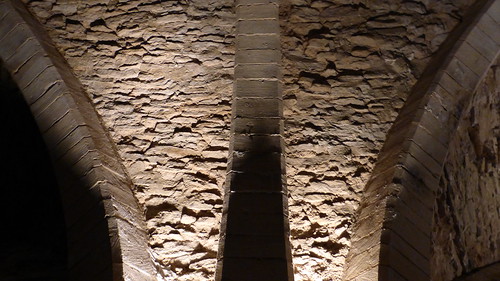
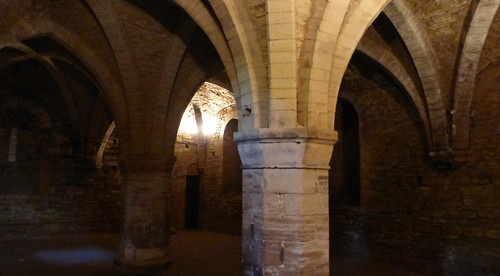 At the back of the château is the entrance to the oldest part of the castle, the vaulted storage rooms. They are dark and damp. There is a good view of the back of the château from here as well.
At the back of the château is the entrance to the oldest part of the castle, the vaulted storage rooms. They are dark and damp. There is a good view of the back of the château from here as well.
 Had some more beautiful weather last week so I drove out to Courseulles-sur-Mer to visit the museum at Juno Beach.
Had some more beautiful weather last week so I drove out to Courseulles-sur-Mer to visit the museum at Juno Beach.  If you don't know what that is, it's the beach where the Canadians landed during D-Day.
If you don't know what that is, it's the beach where the Canadians landed during D-Day. 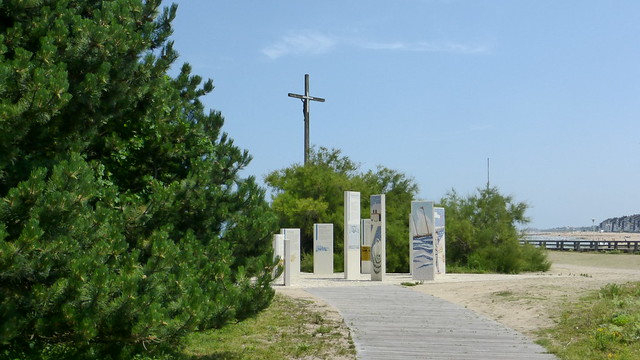 It's hard to believe that 70 years ago over 14,000 men landed here and over 460 lost their lives fighting to liberate France.
It's hard to believe that 70 years ago over 14,000 men landed here and over 460 lost their lives fighting to liberate France. 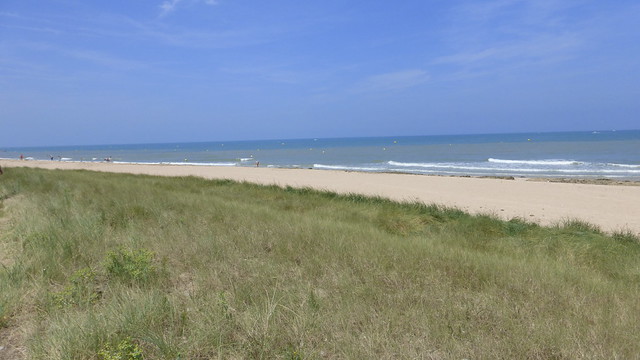 Right on the beach is the museum which pays honor to all the Canadians who participated in the war effort. Maybe its because I'm American but I wasn't wasn't that interested in going inside the museum like I was when it came to visiting the Utah Beach or Omaha Beach museums. Still, I was glad that I got to make it here.
Right on the beach is the museum which pays honor to all the Canadians who participated in the war effort. Maybe its because I'm American but I wasn't wasn't that interested in going inside the museum like I was when it came to visiting the Utah Beach or Omaha Beach museums. Still, I was glad that I got to make it here. 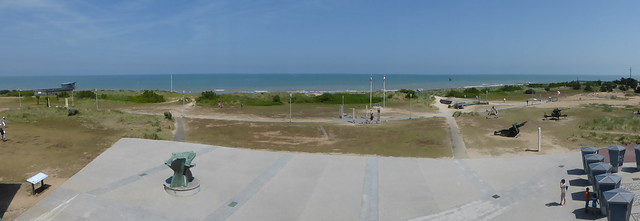
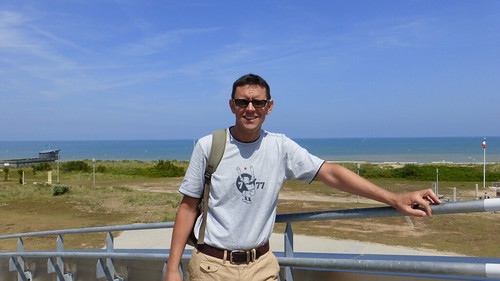
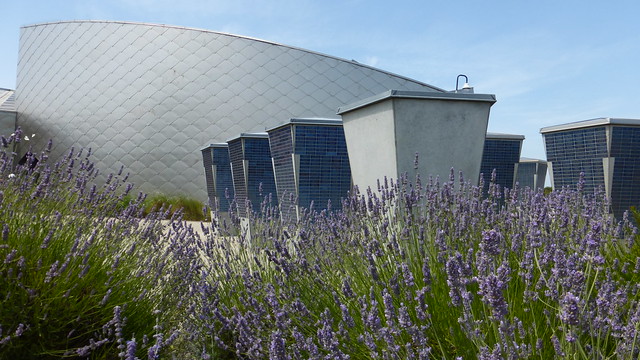 The building itself, designed by Canadian architect Brian K. Chamberlain, is a single-storey structure with five main points, resembling a stylized maple leaf. The exterior is clad in titanium scales and stands about 100 meters back from the present line of sand dunes.
The building itself, designed by Canadian architect Brian K. Chamberlain, is a single-storey structure with five main points, resembling a stylized maple leaf. The exterior is clad in titanium scales and stands about 100 meters back from the present line of sand dunes. 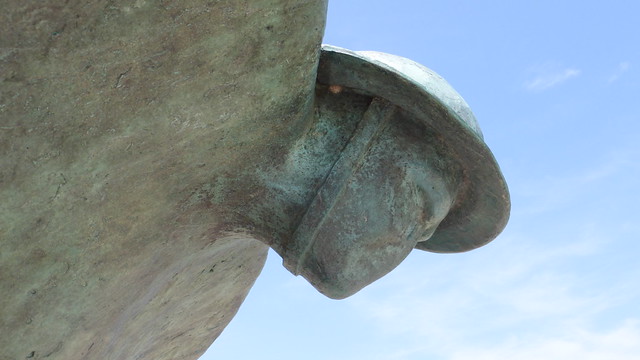
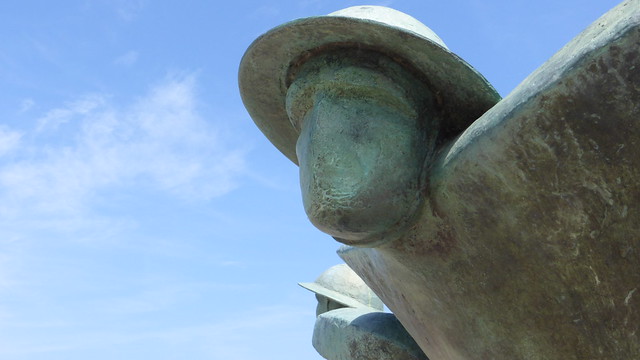
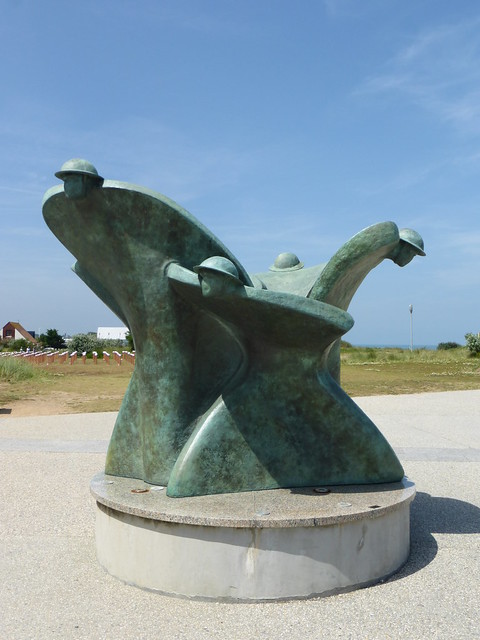 A ceremonial area, which features a statue entitled Remembrance and Renewal, stands between the Centre and the dunes.
A ceremonial area, which features a statue entitled Remembrance and Renewal, stands between the Centre and the dunes. 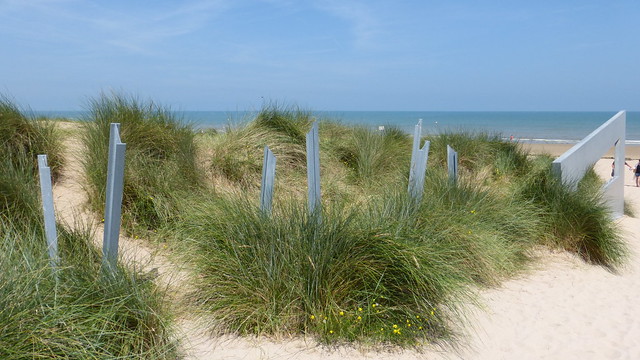
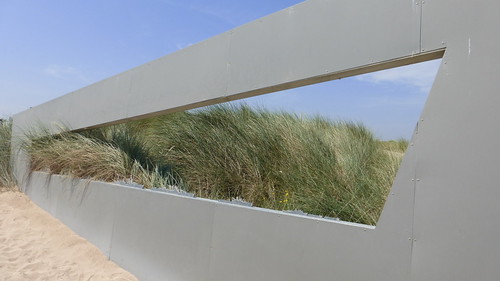
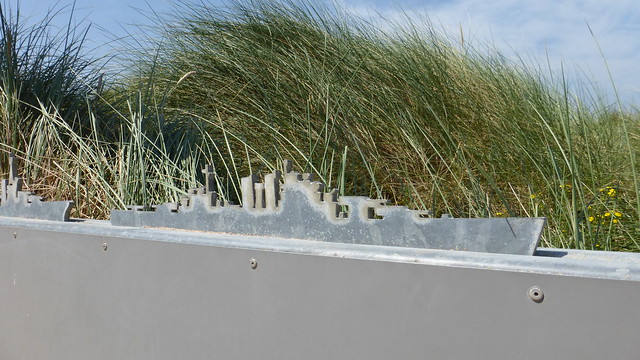 A gap in the dunes is filled by a symbolic structure shaped as a landing craft. An intact German bunker, once an observation post, stands immediately in front of this memorial.
A gap in the dunes is filled by a symbolic structure shaped as a landing craft. An intact German bunker, once an observation post, stands immediately in front of this memorial. 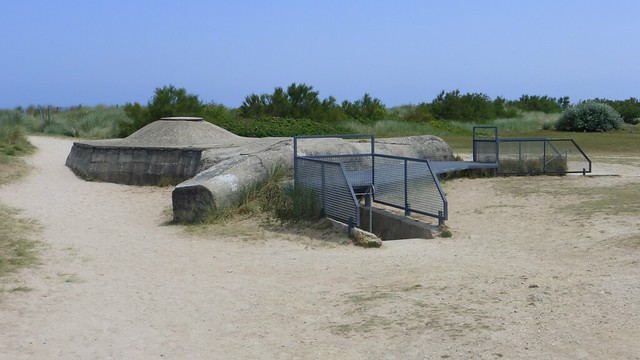
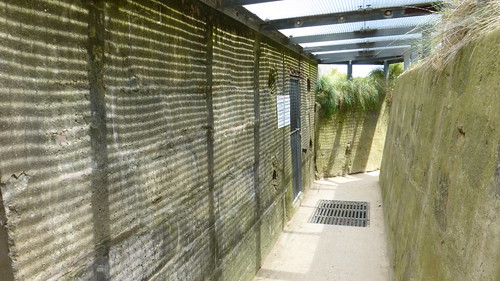
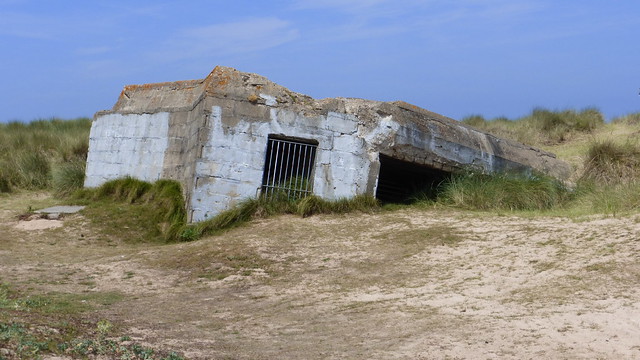 Remnants of the Atlantic Wall remain strewn along the coast, including this half-sunk German gun emplacement. Naturally, such fortifications were deadly obstacles for those wading ashore.
Remnants of the Atlantic Wall remain strewn along the coast, including this half-sunk German gun emplacement. Naturally, such fortifications were deadly obstacles for those wading ashore.  There were even some tetraheaders, pyramid shaped obstacles erected along the shore by the Germans who wanted to destroy any landing ships that happened to invade during high tide. To the left of the museum are several monoliths whith plaques on them.
There were even some tetraheaders, pyramid shaped obstacles erected along the shore by the Germans who wanted to destroy any landing ships that happened to invade during high tide. To the left of the museum are several monoliths whith plaques on them. 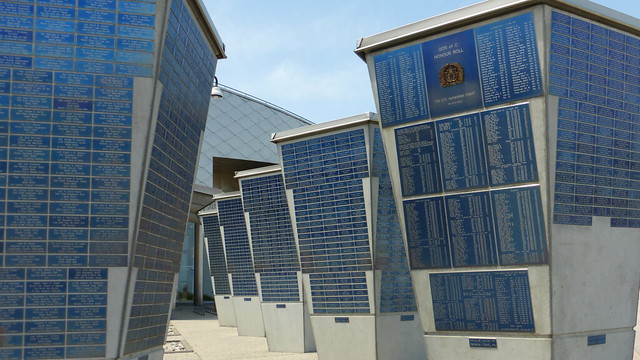
 This is known as the Commemorative Bricks area where doners and veterans can purchase an engraved plaque to be added to the monoliths. Veteran Bricks include the person’s rank, name, decorations, unit, dates of service, as well as a comment regarding the veteran’s service, such as “Italian Campaign”, Battle of the Atlantic”, or “D-Day Veteran”. Also, to the right of the museum is another memorial to those who fell on D-Day--several hundred posts hammered neatly in the sand with name plaques attached.
This is known as the Commemorative Bricks area where doners and veterans can purchase an engraved plaque to be added to the monoliths. Veteran Bricks include the person’s rank, name, decorations, unit, dates of service, as well as a comment regarding the veteran’s service, such as “Italian Campaign”, Battle of the Atlantic”, or “D-Day Veteran”. Also, to the right of the museum is another memorial to those who fell on D-Day--several hundred posts hammered neatly in the sand with name plaques attached. 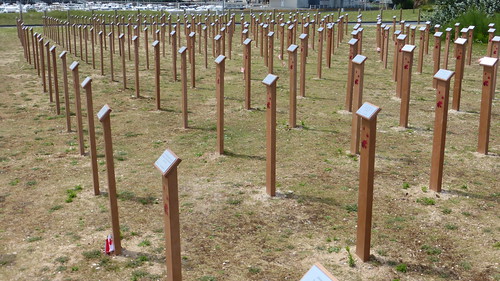 I guess if you can't make it to the cemetery this memorial is a welcome alternative. Nearby, I discovered a pile of stones called an Inuksuk--a symbol of survival among Canada's Inuit peoples. It stands as a guide denoting that humans have passed through that place. This particular Inuksuk was erected in 2005 in remembrance of the First Nations, Metis, and Inuit who served Canada in the Second World War.
I guess if you can't make it to the cemetery this memorial is a welcome alternative. Nearby, I discovered a pile of stones called an Inuksuk--a symbol of survival among Canada's Inuit peoples. It stands as a guide denoting that humans have passed through that place. This particular Inuksuk was erected in 2005 in remembrance of the First Nations, Metis, and Inuit who served Canada in the Second World War.
I went on another wonderful hike last weekend around Amblie in the Calvados Department. The walk has the special name of “randonnée sur les pas des carriers et des meuniers” (which means walking in the footsteps of the quarry-workers and millers) and is tied with the rich history of this area’s occupants. 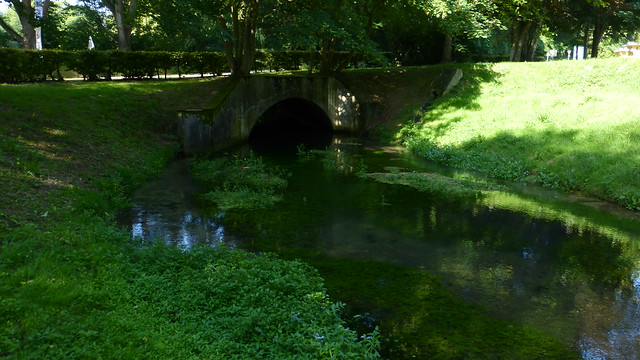 The hike begins from the picnic area in Pierrepont, a small community that belongs to the larger Lantheuil and follows the small river called La Thue.
The hike begins from the picnic area in Pierrepont, a small community that belongs to the larger Lantheuil and follows the small river called La Thue. 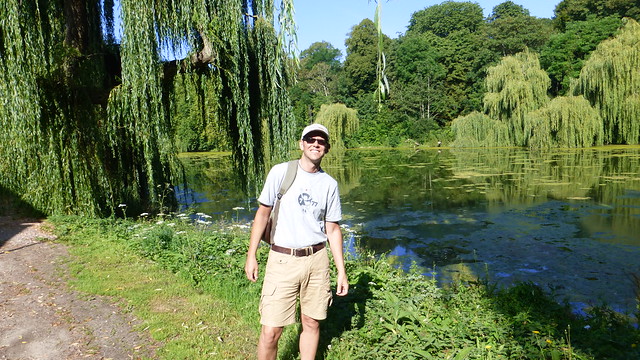
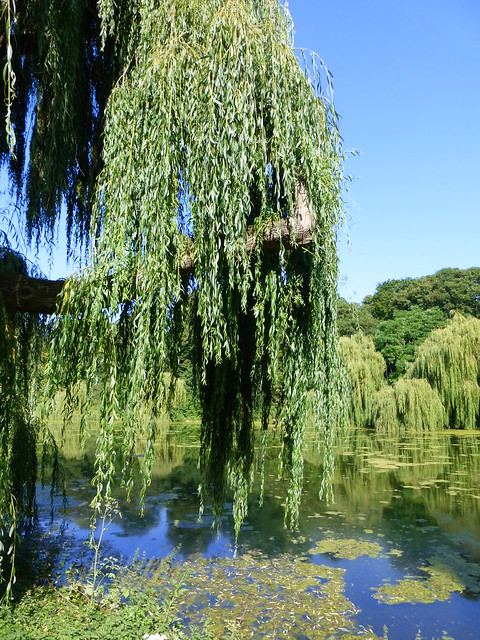 The waterway opens up a bit to create two large ponds shaded by towering willow trees, probably created in the 18th century by the owners of the nearby château. The Château de Pierrepont, built in the 18th century, was the home of the family of Michel Guillaume Jean de Crèvecœur, famous for his “Letters from an American Farmer” (1792).
The waterway opens up a bit to create two large ponds shaded by towering willow trees, probably created in the 18th century by the owners of the nearby château. The Château de Pierrepont, built in the 18th century, was the home of the family of Michel Guillaume Jean de Crèvecœur, famous for his “Letters from an American Farmer” (1792). 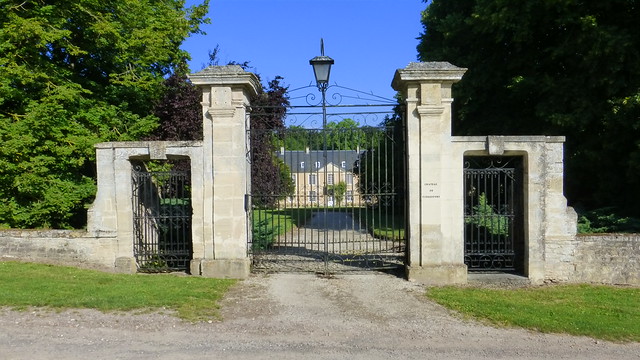
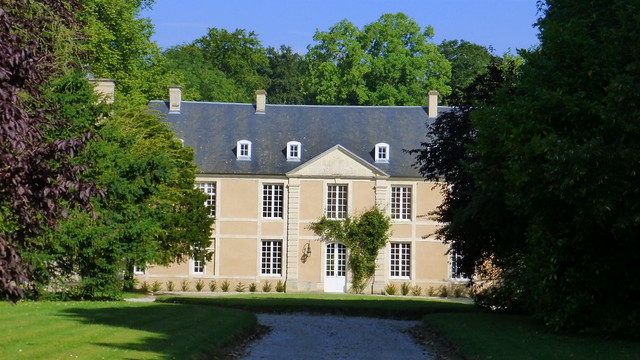 The book was also the first literary success by an American author in Europe and turned Crèvecœur into a celebrated figure. The architecture of the château is typical of the Enlightenment with respect to its symmetry and rectangular pediment as well as the main portal area which is has three openings, as was customary in the 18th century. The farm, the grange and the pressoir portions of the property can be rented out as holiday homes.
The book was also the first literary success by an American author in Europe and turned Crèvecœur into a celebrated figure. The architecture of the château is typical of the Enlightenment with respect to its symmetry and rectangular pediment as well as the main portal area which is has three openings, as was customary in the 18th century. The farm, the grange and the pressoir portions of the property can be rented out as holiday homes. 
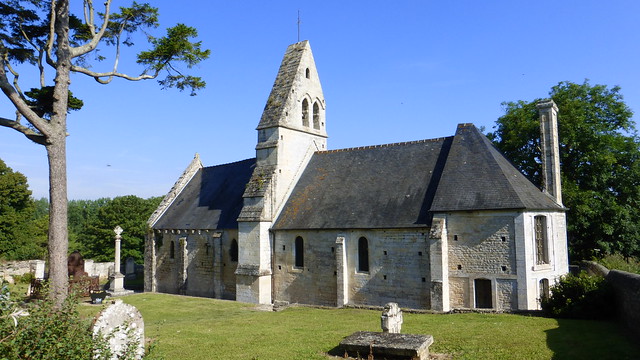 Not far away is the Église de la Sainte-Trinité de Pierrepont which dates from the 11th century.
Not far away is the Église de la Sainte-Trinité de Pierrepont which dates from the 11th century.  The south wall still bears eight typical Romanesque corbels, affixed to a checkerboard frieze.
The south wall still bears eight typical Romanesque corbels, affixed to a checkerboard frieze.  The lintel of one of the bay windows is decorated with animals that seem to be biting their tails.
The lintel of one of the bay windows is decorated with animals that seem to be biting their tails. 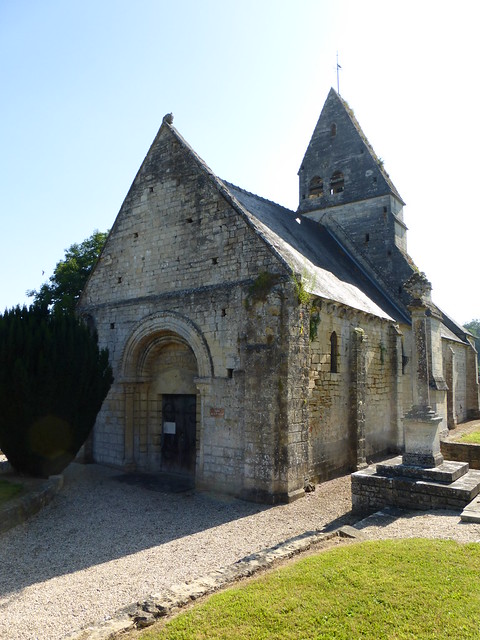 The west portal serves as the main entrance to the nave and is also Romanesque in style. The bell gable is from the 17th century and separates the nave from the choir. A single bell cast in 1868 replaces the two original bells.
The west portal serves as the main entrance to the nave and is also Romanesque in style. The bell gable is from the 17th century and separates the nave from the choir. A single bell cast in 1868 replaces the two original bells. 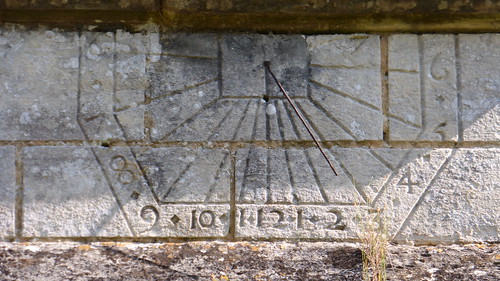 A sundial is set on a flat buttress on the southern side of the church, receives maximum sun throughout the day.
A sundial is set on a flat buttress on the southern side of the church, receives maximum sun throughout the day. 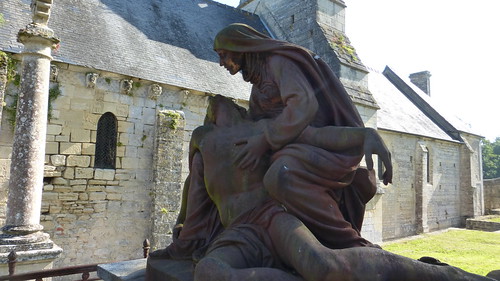 In the churchyard stands a Pieta cast created by J. Sanson in 1869. After leaving the church, I realized that I was going the wrong way and following the trail in a backwards manner. I quickly turned around and went back to my starting point where I found my way again. The trail took me through several fields, some of which were lined with red poppies.
In the churchyard stands a Pieta cast created by J. Sanson in 1869. After leaving the church, I realized that I was going the wrong way and following the trail in a backwards manner. I quickly turned around and went back to my starting point where I found my way again. The trail took me through several fields, some of which were lined with red poppies.  It was a bit of a treat to be able to taste a little of the local produce as I walked.
It was a bit of a treat to be able to taste a little of the local produce as I walked.  In one field I tried some fava beans, also known as fèves—they were almost ripe and ready to be harvested.
In one field I tried some fava beans, also known as fèves—they were almost ripe and ready to be harvested. 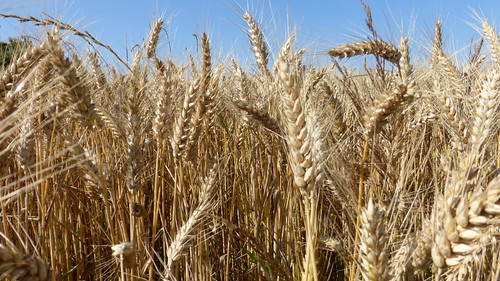
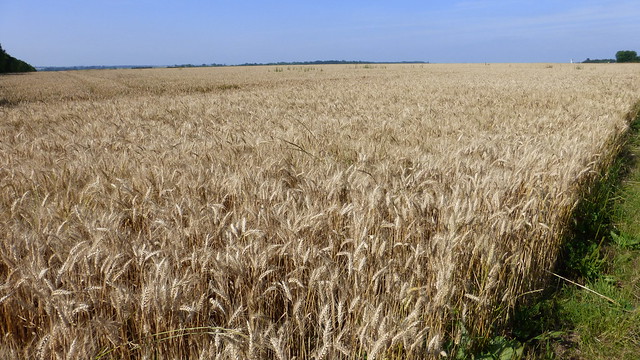 There were many wheat and grain fields as well. I took some grains and rubbed away the chaff just so I could taste the seeds.
There were many wheat and grain fields as well. I took some grains and rubbed away the chaff just so I could taste the seeds. 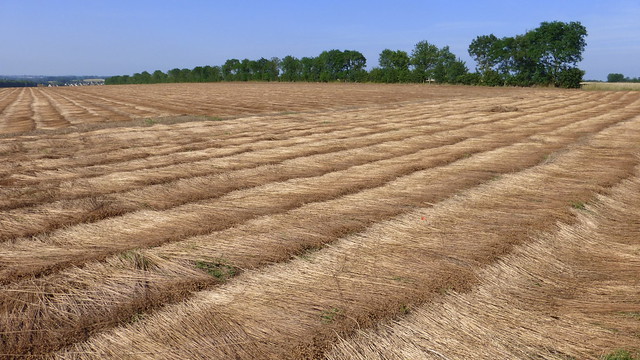
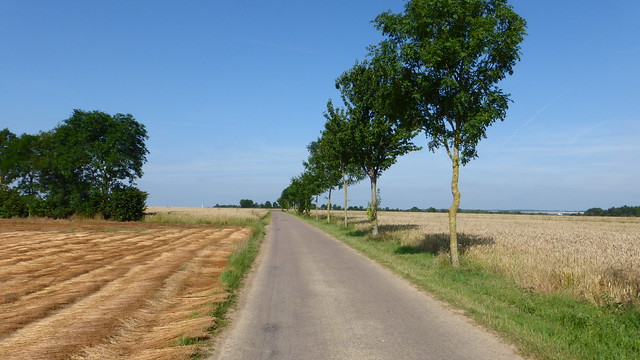 I’ve no idea what this grain is supposed to be—it was perfectly cut and set out in straight rows to dry.
I’ve no idea what this grain is supposed to be—it was perfectly cut and set out in straight rows to dry. 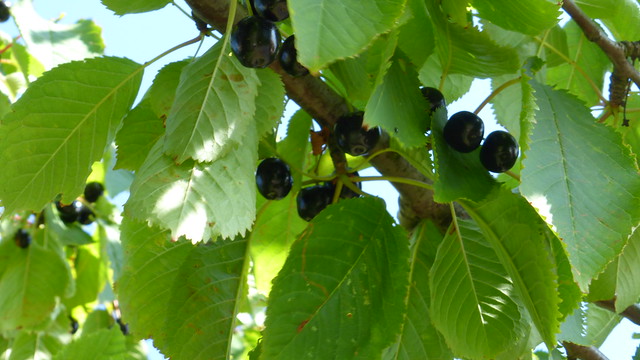 Many parts of the trail were lined with cherry trees with the sweetest, ripest fruit you can imagine. I just reached up and grabbed a handful to snack on while I walked. It’s a shame I can’t get these in the grocery store—the ones in Leclerc have no taste at all.
Many parts of the trail were lined with cherry trees with the sweetest, ripest fruit you can imagine. I just reached up and grabbed a handful to snack on while I walked. It’s a shame I can’t get these in the grocery store—the ones in Leclerc have no taste at all. 
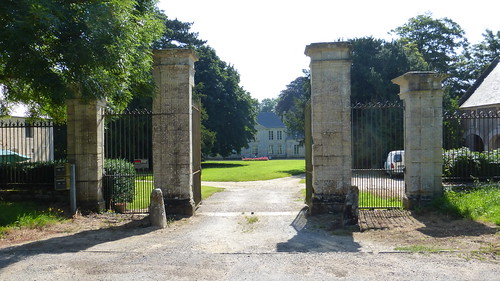

 In Amblie Les Planches I was supposed to see the château but it was on private property and behind a stone wall so all I could see was the main gate, the side buildings and the facade behind a large tree.
In Amblie Les Planches I was supposed to see the château but it was on private property and behind a stone wall so all I could see was the main gate, the side buildings and the facade behind a large tree. 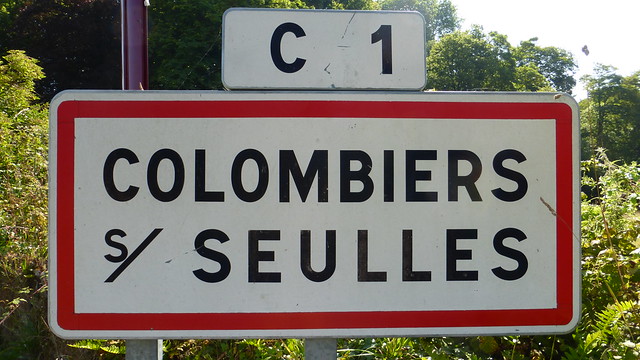
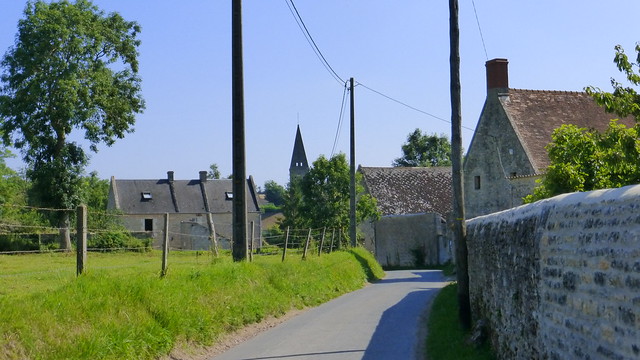 Eventually, I arrived in Colombiers-sur-Seulles where I crossed the River Thue once again in order to visit the Église Saint-Vigor. Unfortunately, it was closed.
Eventually, I arrived in Colombiers-sur-Seulles where I crossed the River Thue once again in order to visit the Église Saint-Vigor. Unfortunately, it was closed. 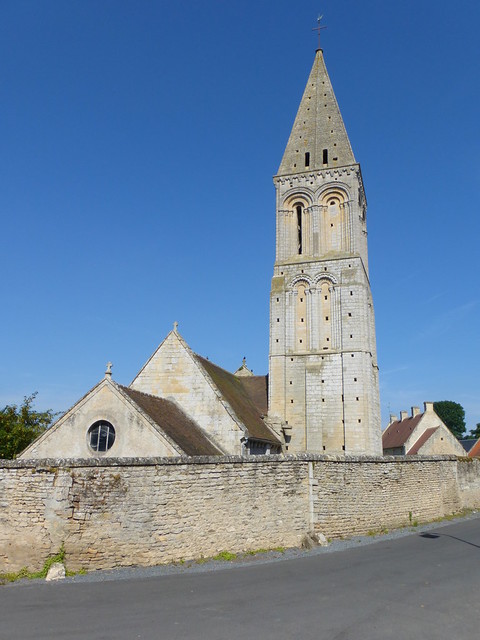 It is dedicated to Saint-Vigor, and evangelist and Bishop of Bayeux during the 6th century. The construction of the church dates back to the late 11th century but has been heavily restored during the 19th. The bell tower however dates from the middle of the 12th century and rests aside from the northern wall near the choir. It is one of the finest examples of Romanesqeue architecture in Calvados.
It is dedicated to Saint-Vigor, and evangelist and Bishop of Bayeux during the 6th century. The construction of the church dates back to the late 11th century but has been heavily restored during the 19th. The bell tower however dates from the middle of the 12th century and rests aside from the northern wall near the choir. It is one of the finest examples of Romanesqeue architecture in Calvados. 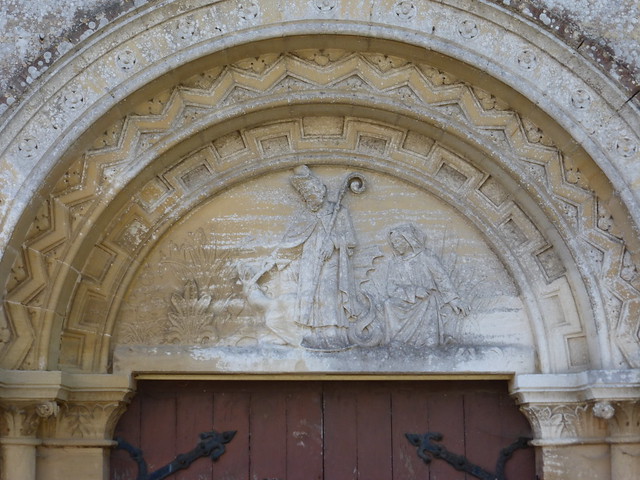 The bas-relief above the main door depicts the story of Saint-Vigor and how he imprisoned the dragon who was terrorizing the people of Cerisy. He tied his stole around the neck of the dragon and brought him to submission. The victory of Catholicism over paganism ? Strangely enough, he didn’t kill the dragon. He instead instructs his young companion, Theudimier to lead the dragon away to the sea.
The bas-relief above the main door depicts the story of Saint-Vigor and how he imprisoned the dragon who was terrorizing the people of Cerisy. He tied his stole around the neck of the dragon and brought him to submission. The victory of Catholicism over paganism ? Strangely enough, he didn’t kill the dragon. He instead instructs his young companion, Theudimier to lead the dragon away to the sea. 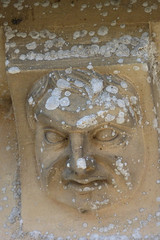
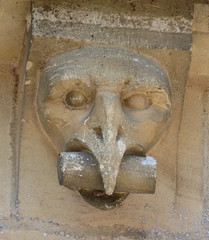
 Corbels on either side of the church are faces of animals or human grotesques.
Corbels on either side of the church are faces of animals or human grotesques.
There is even one making an obscene gesture by bending over and showing his anus ! What's that all about ! 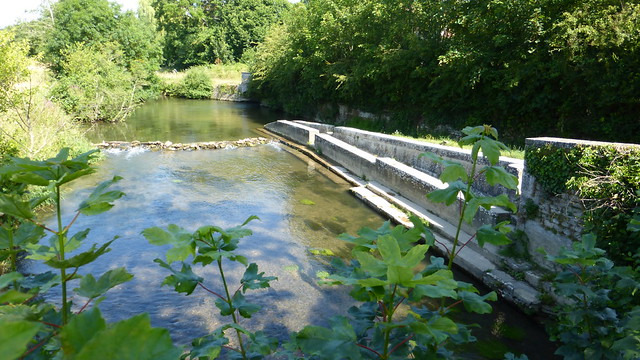 Near the church is a lavoir, a public place for doing washing, which was built in 1864.
Near the church is a lavoir, a public place for doing washing, which was built in 1864. 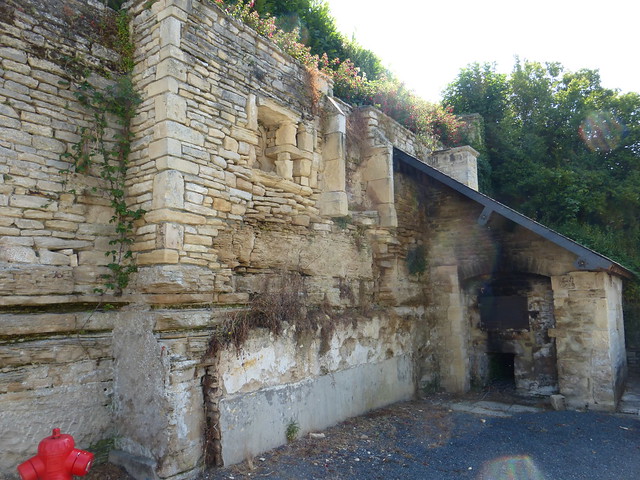 An 18th century baker's oven was found during renovation work in 1996. It was restored thanks to the town council. It must have been in operation during the time of the seigneurs (lords) of Colombiers. In feudal times, the baker's oven was one of the installations owned by the seigneur, which inhabitants of the lord's domain could use in return for a due.
An 18th century baker's oven was found during renovation work in 1996. It was restored thanks to the town council. It must have been in operation during the time of the seigneurs (lords) of Colombiers. In feudal times, the baker's oven was one of the installations owned by the seigneur, which inhabitants of the lord's domain could use in return for a due.  The tithe farm known as the ferme de la dîme, was a dependency of the domain of Colombiers-sur-Seulles. The farm and its buildings span the 17th and 18th centuries but were heavily modified during the 19th and 20th. It is along the rue du Bout du Bas which could be renamed to Thread Street in memory of the numerous lace-makers who used to live there. Lace-making had been a common source of additional income since the Middle Ages.
The tithe farm known as the ferme de la dîme, was a dependency of the domain of Colombiers-sur-Seulles. The farm and its buildings span the 17th and 18th centuries but were heavily modified during the 19th and 20th. It is along the rue du Bout du Bas which could be renamed to Thread Street in memory of the numerous lace-makers who used to live there. Lace-making had been a common source of additional income since the Middle Ages. 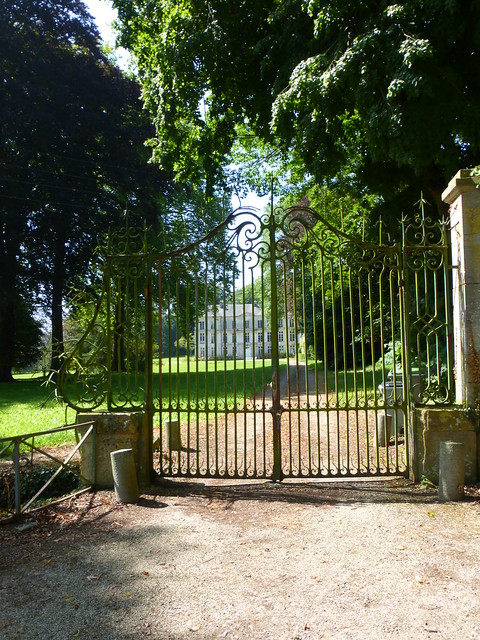
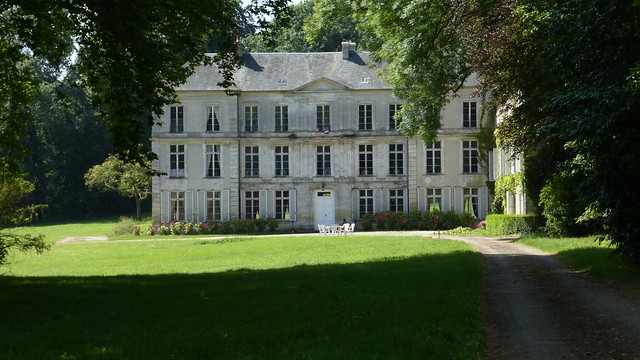 The château de la famille Archard de Bonvouloir is the most impressive of the fine homes one sees along the hike.
The château de la famille Archard de Bonvouloir is the most impressive of the fine homes one sees along the hike. 
It was built in the late 17th century and is surrounded by a large park and even has its own chapel. The building features a central pavillion topped by a triangular pediment flanked by another building on the right. It belongs to the descendants of one of the companions of William the Conqueror at the Battle of Hastings. During World War II the house served as a camp to the thousands of victims and wounded from the bombed out city of Caen. Finally, I reached the town of Amblie proper which is one of those distinguished quaint towns located along the Thue River known for its old mills.
Finally, I reached the town of Amblie proper which is one of those distinguished quaint towns located along the Thue River known for its old mills.
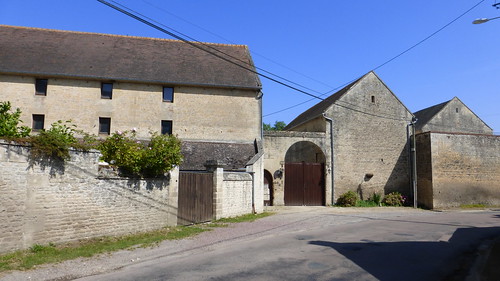 The mills no longer work today and their wheels are all missing but they are really something to see nonetheless.
The mills no longer work today and their wheels are all missing but they are really something to see nonetheless.  Most of them have been transformed into homes. The large houses are built from Caen limestone which is a sort of self-cleaning stone keeping everything looking new and bright.
Most of them have been transformed into homes. The large houses are built from Caen limestone which is a sort of self-cleaning stone keeping everything looking new and bright. 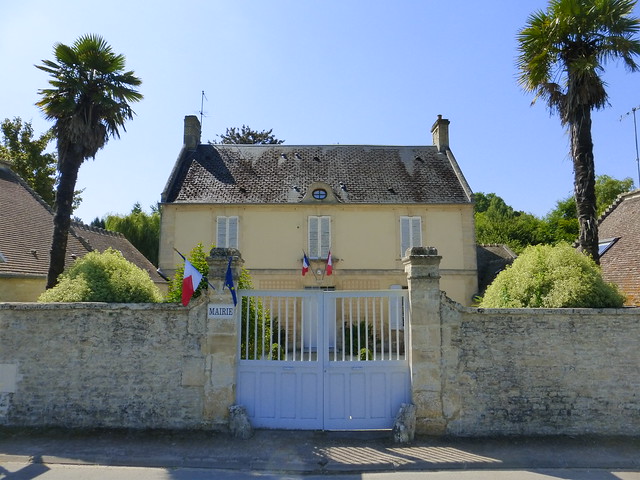 Just past the town hall (and past several more beautiful stone homes and old farms) are the stairs leading up to the Église Saint-Pierre.
Just past the town hall (and past several more beautiful stone homes and old farms) are the stairs leading up to the Église Saint-Pierre. 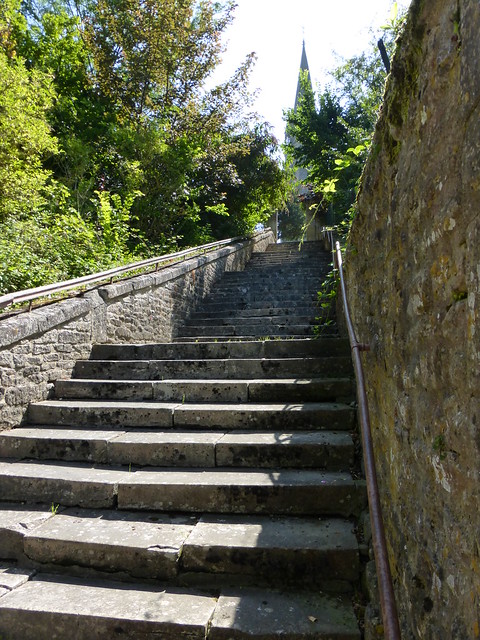
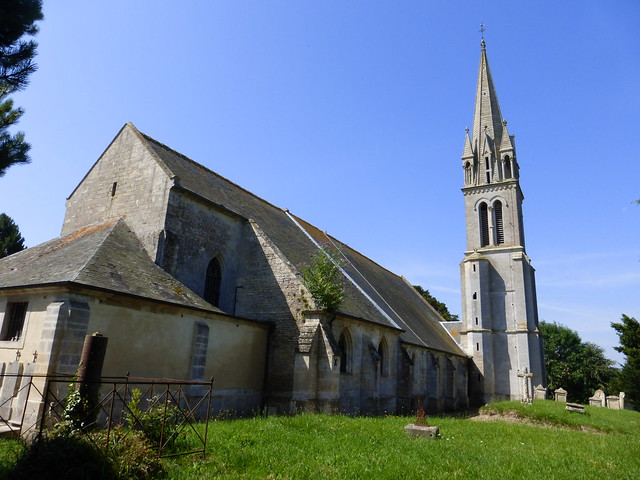 Unfortunately it wasn't open but that's okay, I took the time to just sit down and rest for a while underneath the shade of the cedar tree. The western façade is from the thirteenth century and appears to be the oldest part of the chruch remaining.
Unfortunately it wasn't open but that's okay, I took the time to just sit down and rest for a while underneath the shade of the cedar tree. The western façade is from the thirteenth century and appears to be the oldest part of the chruch remaining. 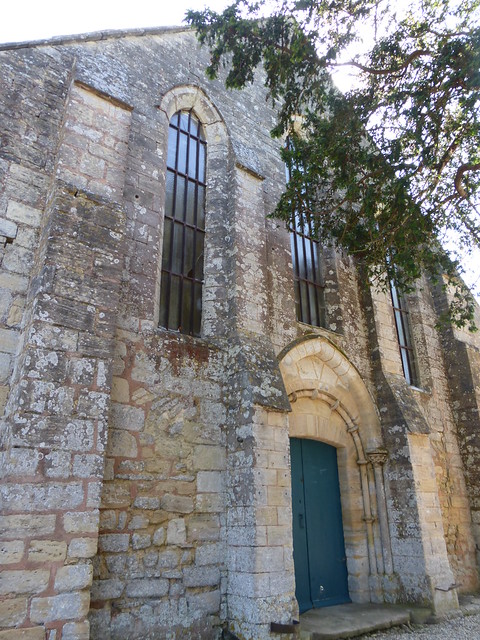
In the 19th century a bell tower replaced a 16th century pinnacle which established an arch separating the choir from the nave. 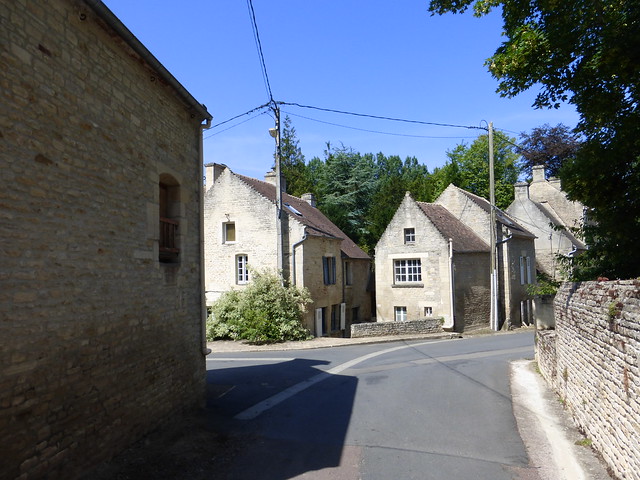

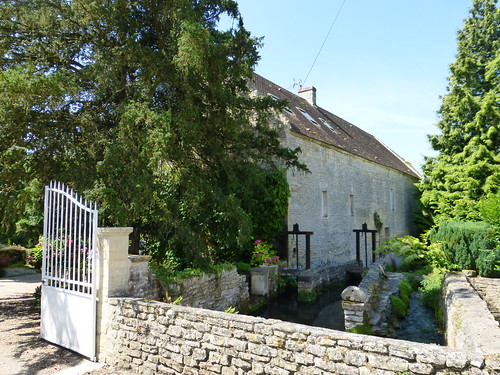
 It was one of the nicest walks I've been on in a long time. The last part of the walk takes you past some trees ripe with plums. Once again, I couldn't help but reach up and help myslef !
It was one of the nicest walks I've been on in a long time. The last part of the walk takes you past some trees ripe with plums. Once again, I couldn't help but reach up and help myslef !
Something different ... Last summer, just before the 69th anniversary of the D-Day landings, I took a trip to Bénouville along the Caen Canal just so I could visit Pegasus Bridge. 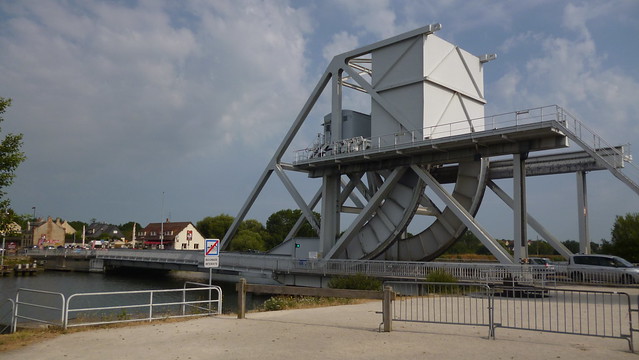 The bridge, which crosses the canal, was built in 1934 but was replaced in 1994. If you've ever seen the film The Longest Day, you'll remember the taking of this bridge was part of a major objective of Operation Deadstick where a glider-borne unit of the British 6th Airborne Division, commanded by Major John Howard, was to land, take the bridge intact and "hold until relieved."
The bridge, which crosses the canal, was built in 1934 but was replaced in 1994. If you've ever seen the film The Longest Day, you'll remember the taking of this bridge was part of a major objective of Operation Deadstick where a glider-borne unit of the British 6th Airborne Division, commanded by Major John Howard, was to land, take the bridge intact and "hold until relieved." 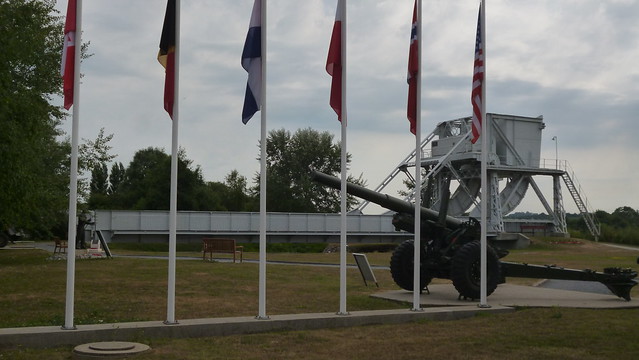 The successful taking of the bridge played an important role in limiting the effectiveness of a German counter-attack in the days and weeks following the invasion. The original Pegasus Bridge now resides in the grounds of the Pegasus Museum. After its replacement, Pegasus Bridge was left on waste ground until it was sold to the museum for the symbolic price of one Franc.
The successful taking of the bridge played an important role in limiting the effectiveness of a German counter-attack in the days and weeks following the invasion. The original Pegasus Bridge now resides in the grounds of the Pegasus Museum. After its replacement, Pegasus Bridge was left on waste ground until it was sold to the museum for the symbolic price of one Franc. 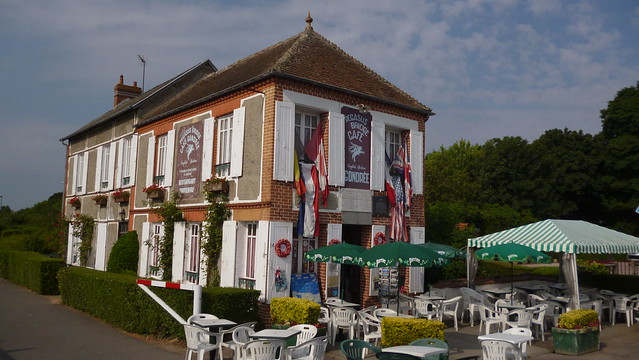 Across the street is the famous Café Gondrée, the first French house to be liberated during D-Day.
Across the street is the famous Café Gondrée, the first French house to be liberated during D-Day. 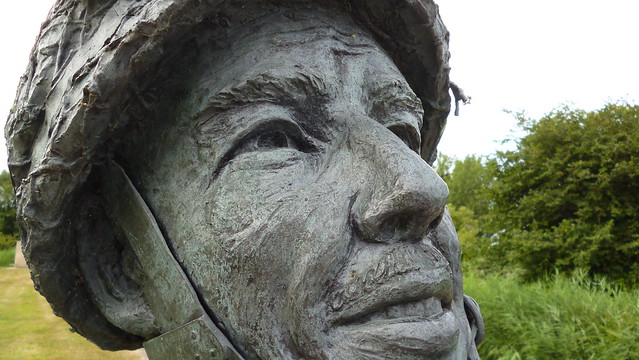
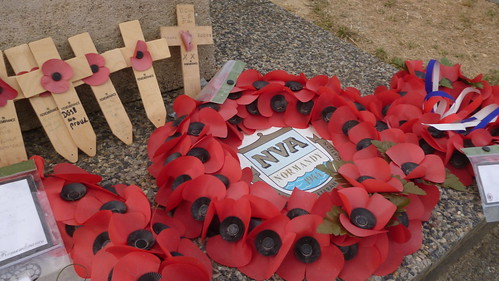 On the other side of the bridge is the memorial to Major John Howard.
On the other side of the bridge is the memorial to Major John Howard.
While driving home, approaching the small town of Surville and the flat green earth of this low lying land all around me I could easily see in the distance this small church directly beside the road. What struck me first was the imposing bell tower which looked like a fortified keep. Like so many churches in the area, I assumed that it once served as a lookout tower for invaders from the sea. Inside, there is a lot of information about the liturgical furniture but little history about the origins of the church itself. I found some information online. It turns out that the original construction was built in the 13th and 14th centuries and served as a chapel dedicated to Sainte-Anne for the owners of the château. It became a church much later. I’d like to say a special thank you to Le Chevalier Dauphinois, a fellow over-blogger for his interesting insights on this place.  The painted wood of the main altar and its retable were actually built during the 19th century from a recycled 17th century altarpiece. At the center is a painting of the Resurrection of Christ and on either side are statues of the Virgin and Child as well as Saint John the Baptist.
The painted wood of the main altar and its retable were actually built during the 19th century from a recycled 17th century altarpiece. At the center is a painting of the Resurrection of Christ and on either side are statues of the Virgin and Child as well as Saint John the Baptist. 

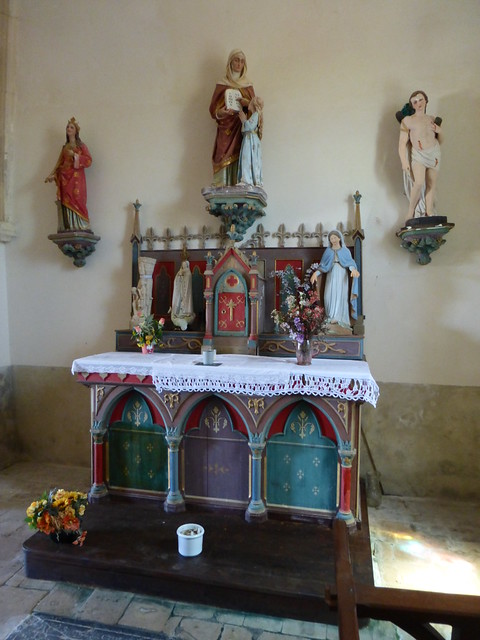 There is another beautifully painted altar in the chapel dedicated to the Virgin. Statues resting on the altar are all depictions of the Virgin while the other three represent Sainte-Barbara, Sainte-Anne and Saint-Sébastien.
There is another beautifully painted altar in the chapel dedicated to the Virgin. Statues resting on the altar are all depictions of the Virgin while the other three represent Sainte-Barbara, Sainte-Anne and Saint-Sébastien.  The baptismal font is made from marble from Montmartin and dates from the early 19th century.
The baptismal font is made from marble from Montmartin and dates from the early 19th century.  Just opposite is an early 19th century confessional.
Just opposite is an early 19th century confessional. 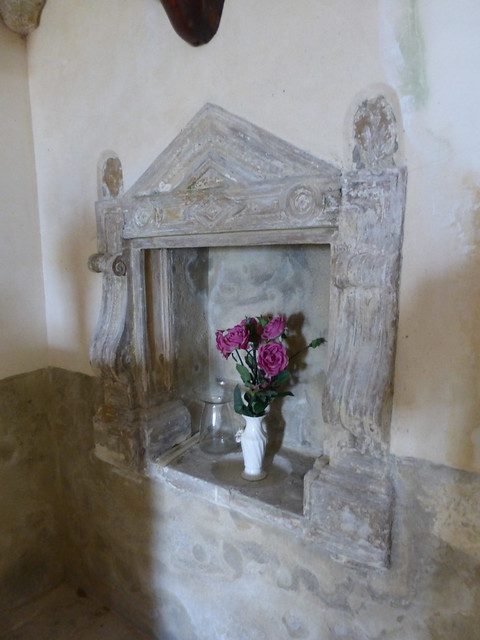 Along the wall of the same chapel you can admire a carved limestone credenza from 1554 which has a special hole in the bottom of the receptacle for holy water to return to the foundations of the church.
Along the wall of the same chapel you can admire a carved limestone credenza from 1554 which has a special hole in the bottom of the receptacle for holy water to return to the foundations of the church. 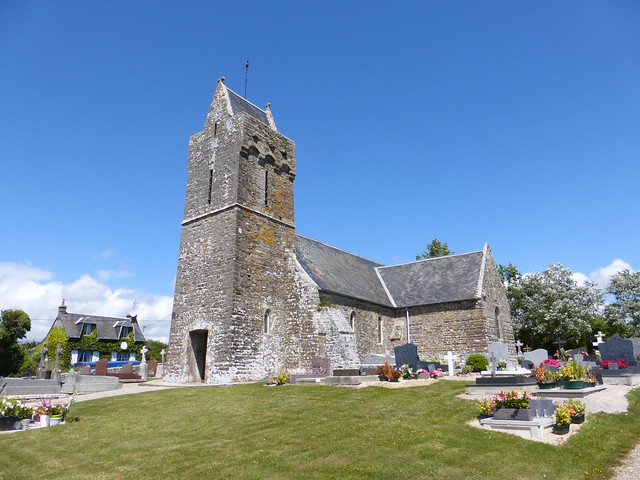 Across the street from the church is the Château de Surville which can be rented out for receptions, weddings and conferences.
Across the street from the church is the Château de Surville which can be rented out for receptions, weddings and conferences.
There is so much information about this town online that it is overwhelming. I’ll try to be concise and too the point but if you are interested in all the facts just check out their link online. After a long day of hiking and visiting old churches, I had one more stop to make in Saint-Germain-sur-Ay to see the old church and its priory as well as the old harbour now known as le havre which is watched over by the corps de garde, a 17th century guardhouse.  The Église Saint-Germain dates from the 12th century and has simple architectural design with an absence of a monumental gate. It therefore respected the Benedictine Rule which did not seek distractions of the mind. It is on the 14th century fortified bell tower that you can see a noticeable effort with sculpture—here there are eight windows, of which four have grotesque faces carved into corbels above the arches.
The Église Saint-Germain dates from the 12th century and has simple architectural design with an absence of a monumental gate. It therefore respected the Benedictine Rule which did not seek distractions of the mind. It is on the 14th century fortified bell tower that you can see a noticeable effort with sculpture—here there are eight windows, of which four have grotesque faces carved into corbels above the arches. 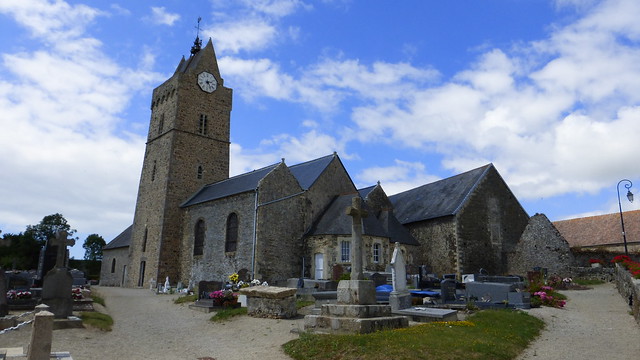 The tower also has false battlements which are simply decorative and devoid of openings for shooting. Despite this, the false machicolations were intended to strengthen the defensive tower and deter invaders. Indeed, in the 14th century English raids were frequent and deadly. The tower was part of a network of fortified churches in the Cotentin that could allow local populations to use them as defensive positions when needed. The inside has a single nave and two side aisles separated by simple Romanesque arches.
The tower also has false battlements which are simply decorative and devoid of openings for shooting. Despite this, the false machicolations were intended to strengthen the defensive tower and deter invaders. Indeed, in the 14th century English raids were frequent and deadly. The tower was part of a network of fortified churches in the Cotentin that could allow local populations to use them as defensive positions when needed. The inside has a single nave and two side aisles separated by simple Romanesque arches. 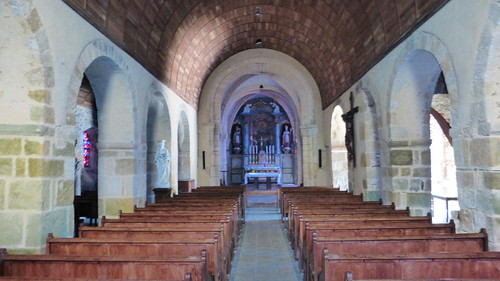 The choir and the nave are separated by another large Romanesque arch. Motifs of animals and plants adorn many of the capitals above the columns in the choir.
The choir and the nave are separated by another large Romanesque arch. Motifs of animals and plants adorn many of the capitals above the columns in the choir. 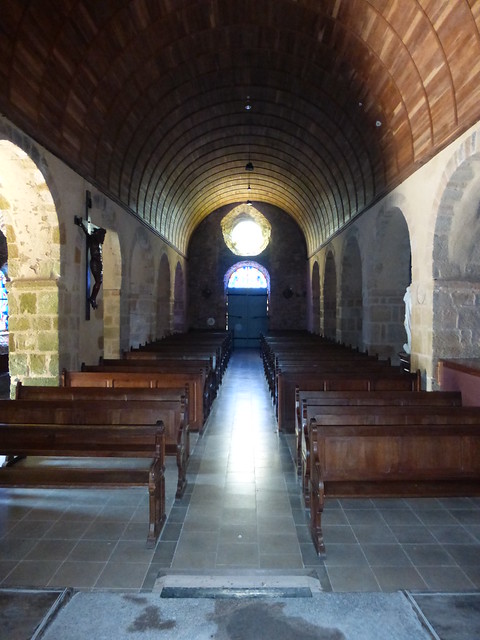 The nave is the part of the building with the least amount of decoration and has undergone the most changes over the last century which included new wood vaulting installed in 1954.
The nave is the part of the building with the least amount of decoration and has undergone the most changes over the last century which included new wood vaulting installed in 1954. 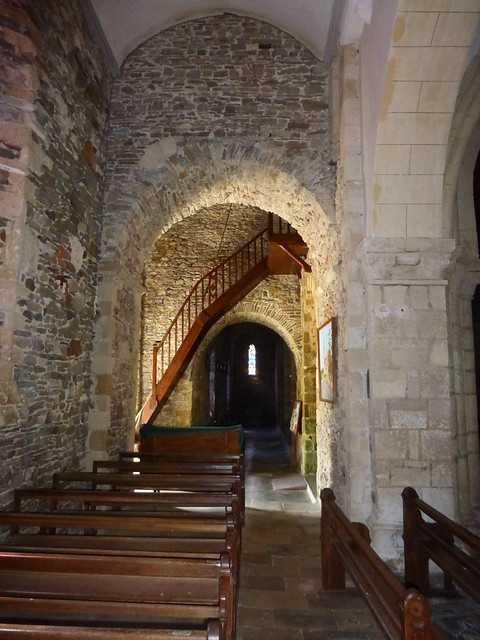 A staircase beneath the tower leads to the three bells of the church. Inside, the church has two works listed as historical monuments:
A staircase beneath the tower leads to the three bells of the church. Inside, the church has two works listed as historical monuments: 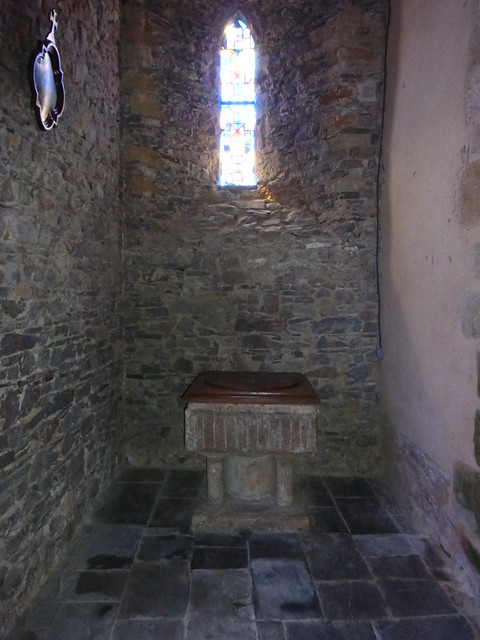 The medieval baptismal font...
The medieval baptismal font...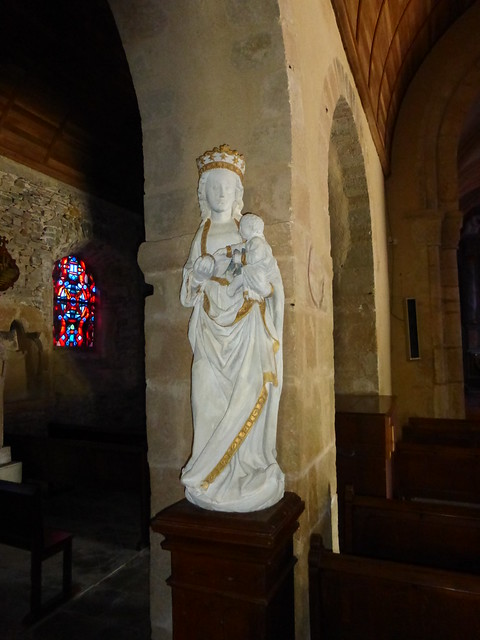 ...and the 15th century statue of the Virgin and Child.
...and the 15th century statue of the Virgin and Child. 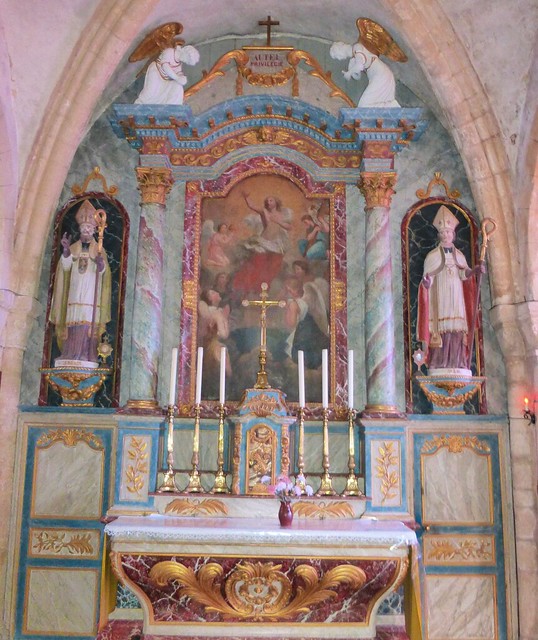 The wooden altar from 1828 is painted in faux marble with two kneeling angels at the top. On either side are statues of Saint-Germain and Saint-Lo with a painting depicting Christ’s Resurrection at the center.
The wooden altar from 1828 is painted in faux marble with two kneeling angels at the top. On either side are statues of Saint-Germain and Saint-Lo with a painting depicting Christ’s Resurrection at the center. 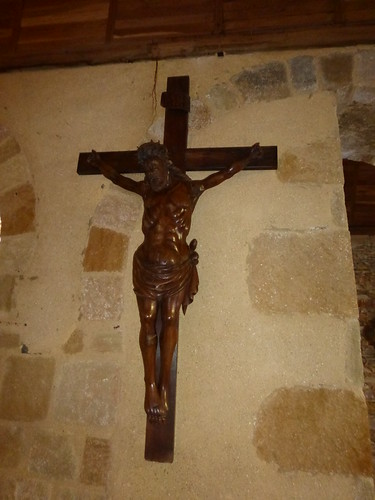 I found a source that says the crucifixion is from the medieval era but I really doubt that since it isn’t in the correct fashion for that time.
I found a source that says the crucifixion is from the medieval era but I really doubt that since it isn’t in the correct fashion for that time. 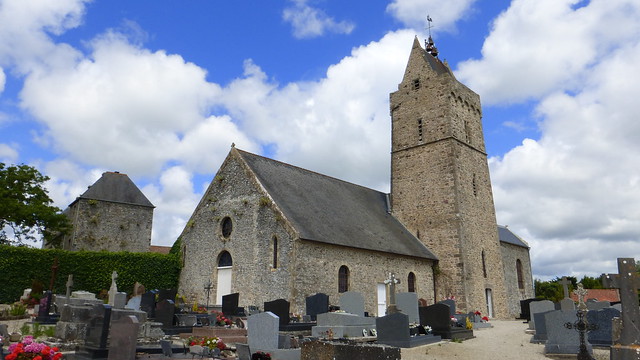

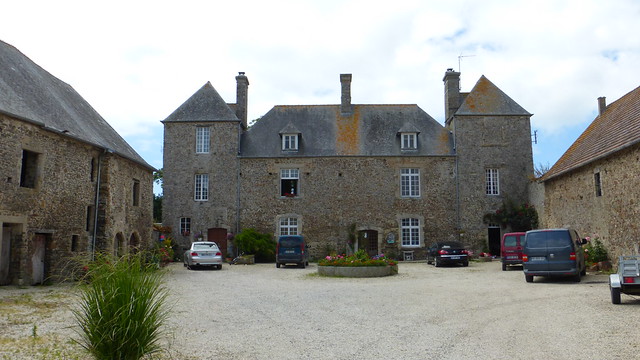 In the shadow of the church is the 12th century priory which was the home to Benedictine monks.
In the shadow of the church is the 12th century priory which was the home to Benedictine monks. 

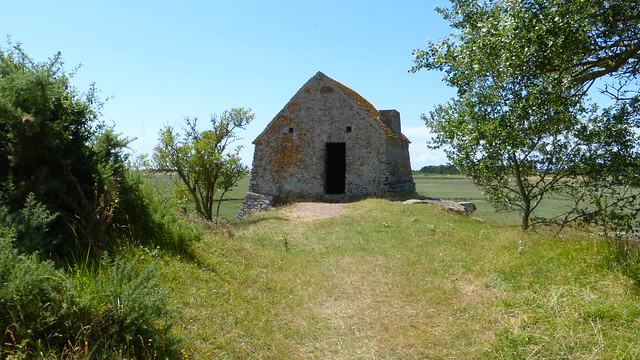 The corps de garde (guard house) has very old origins and is without a doubt part of a defence system whose purpose was to protect the region from Viking invasions. Although driven out of France in 1450, the English continued to harass the commercial fleet and to carry out raids in the country on the beaches by seizing merchandise, animals and boats at the quayside.
The corps de garde (guard house) has very old origins and is without a doubt part of a defence system whose purpose was to protect the region from Viking invasions. Although driven out of France in 1450, the English continued to harass the commercial fleet and to carry out raids in the country on the beaches by seizing merchandise, animals and boats at the quayside. 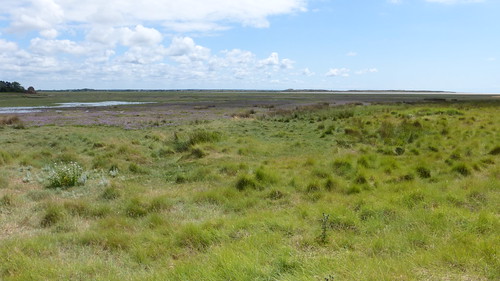
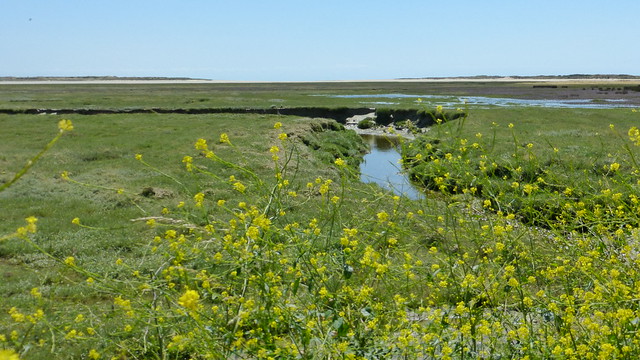 They attacked the ports of Cherbourg, St-Vaast, Carteret, Portbail and St-Germain-sur-Ay. Guard posts were built all along the west coast of the Cotentin in order to ensure the surveillance and protection of the marine traffic, particularly boats in the process of landing and unloading. The harbor (called, le havre in French) of St-Germain was much bigger than it is today, protecting the village of Salines, that you can see on the other side of the bridge, and possessed a very busy port receiving boats of 400 tons specializing in the commerce of wood, sea salt cereals and animals. The small village of les Salines owes its name to the practice of extracting salt which was done at this period.
They attacked the ports of Cherbourg, St-Vaast, Carteret, Portbail and St-Germain-sur-Ay. Guard posts were built all along the west coast of the Cotentin in order to ensure the surveillance and protection of the marine traffic, particularly boats in the process of landing and unloading. The harbor (called, le havre in French) of St-Germain was much bigger than it is today, protecting the village of Salines, that you can see on the other side of the bridge, and possessed a very busy port receiving boats of 400 tons specializing in the commerce of wood, sea salt cereals and animals. The small village of les Salines owes its name to the practice of extracting salt which was done at this period.  The sea, with the passage of time silted up the harbor and the commercial traffic collapsed. The guard house was built in 1659 on a rock five meters high, allowing one a view of the whole of the harbor. Under military command, it was run by 2 officers and 10 men. As a reprisal for the help given to the Protestants in La Rochelle, Richelieu ordered the destruction of the port facilities but the guard house was not touched.
The sea, with the passage of time silted up the harbor and the commercial traffic collapsed. The guard house was built in 1659 on a rock five meters high, allowing one a view of the whole of the harbor. Under military command, it was run by 2 officers and 10 men. As a reprisal for the help given to the Protestants in La Rochelle, Richelieu ordered the destruction of the port facilities but the guard house was not touched. 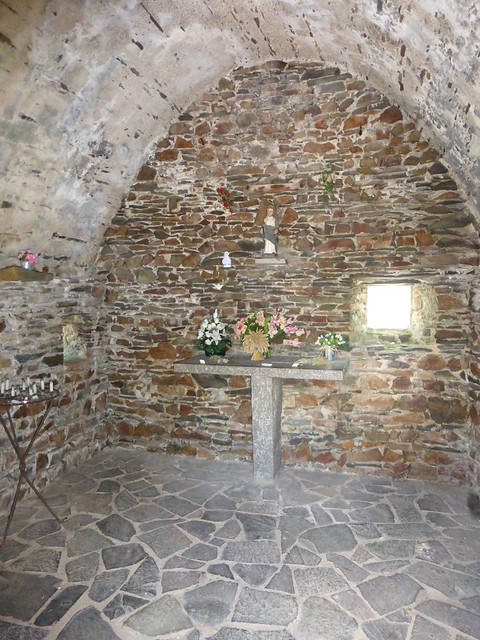 It was transformed into a chapel on the July 29, 1945 and assumed the name of Notre-Dame du Rosaire, but was called Notre-Dame du Grappillon (from the name of the place where the sheep of the salt marshes fed in the harbor) by locals.
It was transformed into a chapel on the July 29, 1945 and assumed the name of Notre-Dame du Rosaire, but was called Notre-Dame du Grappillon (from the name of the place where the sheep of the salt marshes fed in the harbor) by locals. 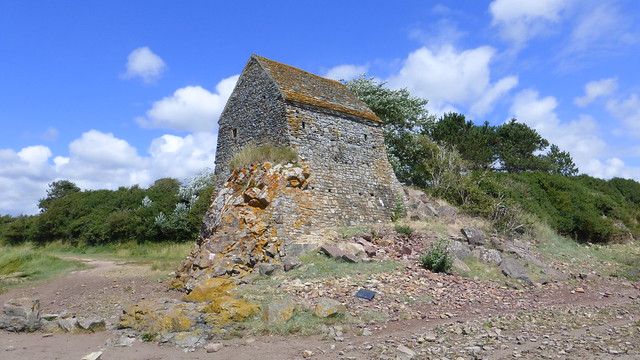 The families Deshayes-Alliot gave it as a gift to the commune on condition that it was to be restored to its original state. The commune accepted it and from 1977, at the instigation of the committee of preservation created that same year, volunteers carried out considerable restoration work.
The families Deshayes-Alliot gave it as a gift to the commune on condition that it was to be restored to its original state. The commune accepted it and from 1977, at the instigation of the committee of preservation created that same year, volunteers carried out considerable restoration work.
I’ve not much to say about the Église Saint-Pair in Gerville-la-Forêt except that it is from the 17th century and was closed on the day I visited. It’s the little church I came across while looking for the chapel in Vesly. The church gets its name from Saint-Paternus (or Saint-Pair) of Avranches who is said to have been born in Poitiers, become a monk at the Abbey of Marnes in France and retreated with his fellow monk, Saint Scubilion to the forest of Seicy in the diocese of Coutances before the Bishop of Coutances made him a priest in 512. The town itself is now part of Vesly but its name derives from the name of the old lords of the land, les Gervilles and the addition of la forêt which is a reference to the nearby forest of Lessay. You learn something new every day.
Well, this was one of those pleasant surprises that you just don’t come across that often. After visiting the church in Vesly, I wanted to find the Chapelle Notre-Dame de la Consolation but was disappointed when I couldn’t find any signs in town leading me there. I ended up driving in the wrong direction and found myself in Gerville-la-Forêt where I came across another church called Église Saint-Pair (which happened to be closed). Fortunately, there was a large map posted just in front of the church that gave directions to the chapel. So, I drove back into Vesly and found it without any further problems. It is nestled at the highest part of the town at the top of a path leading to the parsonage, past the local soccer field in amongst a small copse of trees. The chapel has been restored several times over the centuries. Information in a variety of languages can be found inside but there is very little information about the history of this chapel online. I’ll reprint what I found here: 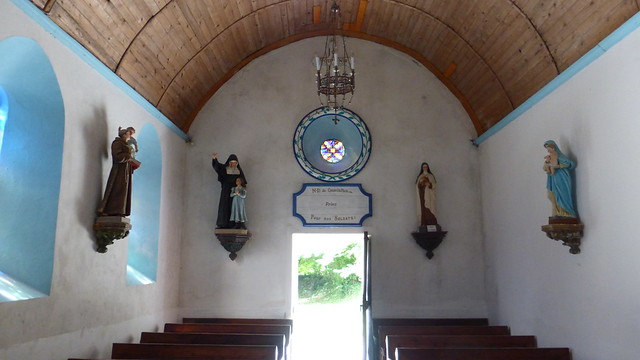 In the 13th century, a gentleman was riding in the vicinity of the place where the chapel is now standing. Suddenly, he came across a boar which rushed at the horse. The horse bolted and knocked the knight down. Unfortunately, one of the knight’s feet got stuck in the stirrup and he was dragged by the bolting horse. When he was about to die, the gentleman promised the Blessed Virgin that he would build a chapel at the very place where his life would be spared. His foot being released, the gentleman soon set about fulfilling his vow. He dedicated the chapel he built to Our Lady of the Stirrup (Notre-Dame de l'Étrier) or of the Saddle (Notre-Dame de la Selle). Such is the origin, according to legend, of the Vesly Chapel.
In the 13th century, a gentleman was riding in the vicinity of the place where the chapel is now standing. Suddenly, he came across a boar which rushed at the horse. The horse bolted and knocked the knight down. Unfortunately, one of the knight’s feet got stuck in the stirrup and he was dragged by the bolting horse. When he was about to die, the gentleman promised the Blessed Virgin that he would build a chapel at the very place where his life would be spared. His foot being released, the gentleman soon set about fulfilling his vow. He dedicated the chapel he built to Our Lady of the Stirrup (Notre-Dame de l'Étrier) or of the Saddle (Notre-Dame de la Selle). Such is the origin, according to legend, of the Vesly Chapel. 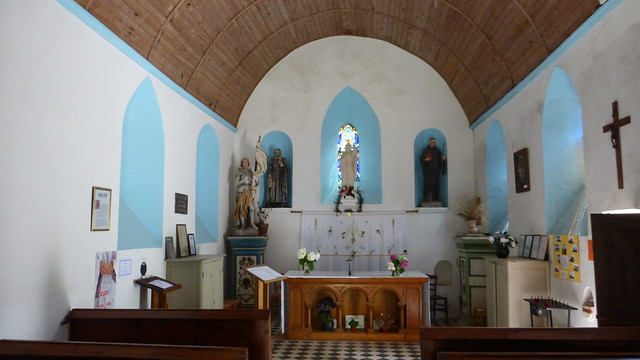 As for its cloister, in the 14th and 15th centuries, it was used as the burial place for the local gentry. Over the years, many old sarcophagi have been found here during archaeological digs. In 1650, Father John Eudes, preaching a mission in Vesly, found the chapel nearly in ruins. It was a long time since Mass had been said. The missionary announced a procession to the chapel on Easter Tuesday. The parishioners of Vesly and of the neighbourhood responded to the appeal. Father Eudes then felt a desire to restore the chapel of the Blessed Virgin during his stay in Vesly. This task was undertaken so eagerly that the missionary was able to say Mass in the newly restored chapel at the end of his mission. Seeing this achievement as a good sign from the Blessed Virgin that his mission was a success, Father Eudes then dedicated the chapel to Our Lady of Consolation which is now its name. The interior has eight statues:
As for its cloister, in the 14th and 15th centuries, it was used as the burial place for the local gentry. Over the years, many old sarcophagi have been found here during archaeological digs. In 1650, Father John Eudes, preaching a mission in Vesly, found the chapel nearly in ruins. It was a long time since Mass had been said. The missionary announced a procession to the chapel on Easter Tuesday. The parishioners of Vesly and of the neighbourhood responded to the appeal. Father Eudes then felt a desire to restore the chapel of the Blessed Virgin during his stay in Vesly. This task was undertaken so eagerly that the missionary was able to say Mass in the newly restored chapel at the end of his mission. Seeing this achievement as a good sign from the Blessed Virgin that his mission was a success, Father Eudes then dedicated the chapel to Our Lady of Consolation which is now its name. The interior has eight statues: 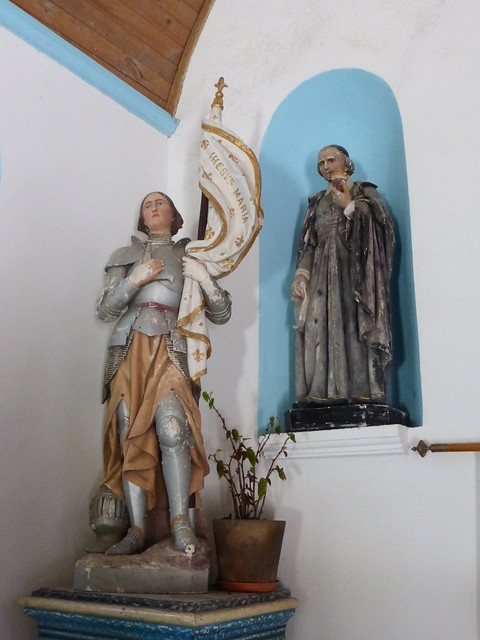 Sainte-Jeanne d'Arc and Saint-Jean Eudes
Sainte-Jeanne d'Arc and Saint-Jean Eudes 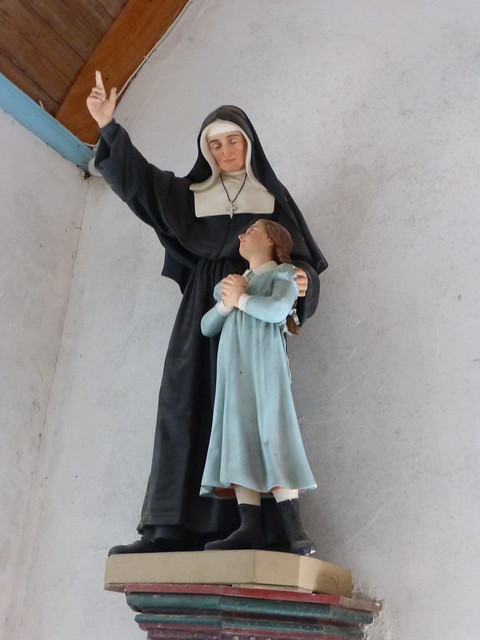 Sainte-Marie-Madeleine Postel
Sainte-Marie-Madeleine Postel 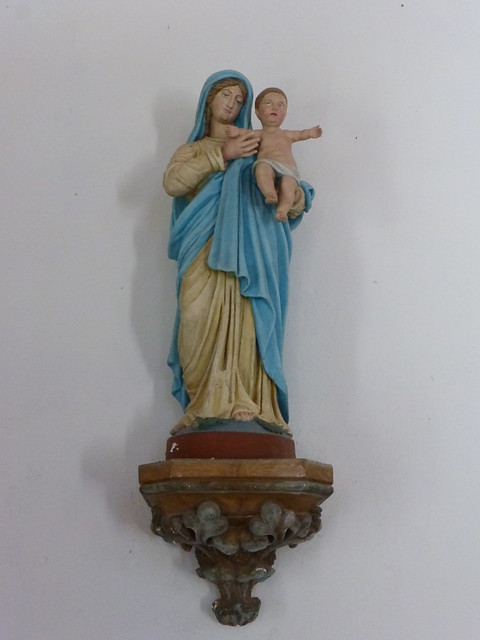 Notre-Dame de l’Huis Ouvert
Notre-Dame de l’Huis Ouvert 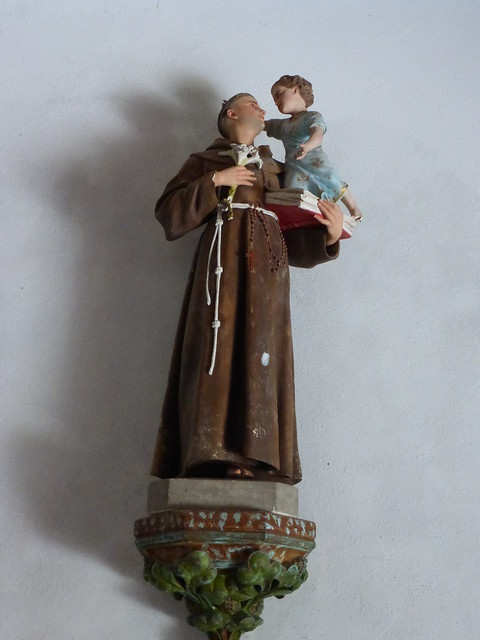 Saint-Antoine de Padoue
Saint-Antoine de Padoue 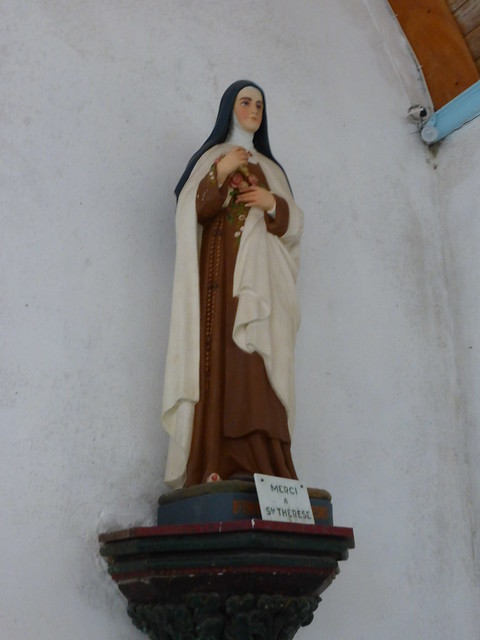 Sainte-Thérèse de l’Enfant-Jésus
Sainte-Thérèse de l’Enfant-Jésus 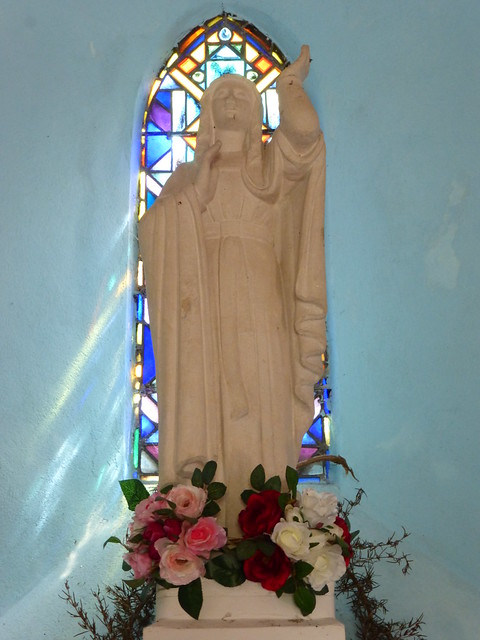 Notre-Dame de la Consolation
Notre-Dame de la Consolation 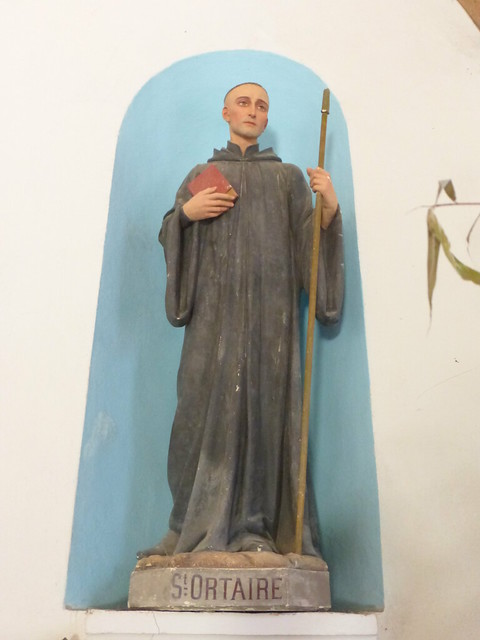 Saint-Ortaire
Saint-Ortaire
The windows are of note also for being from the workshop of famous glass maker Mauméjean. 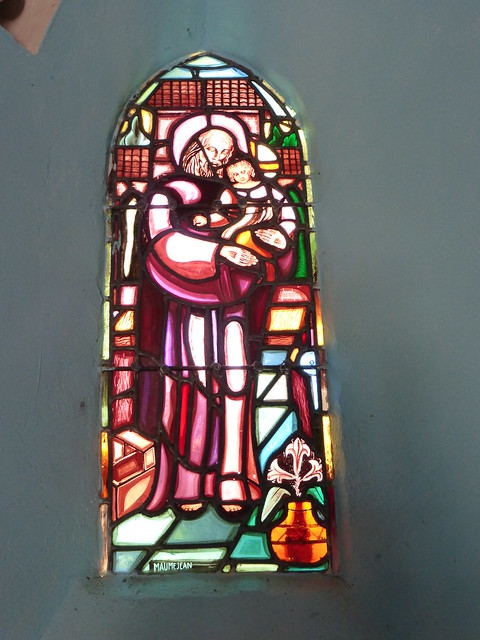 The first one depicts Saint-Joseph carrying the infant Jesus.
The first one depicts Saint-Joseph carrying the infant Jesus.  The second one depicts the apparition of the Virgin to Ste-Catherine Labouré in the chapel at the convent at Rue du Bac in Paris.
The second one depicts the apparition of the Virgin to Ste-Catherine Labouré in the chapel at the convent at Rue du Bac in Paris. 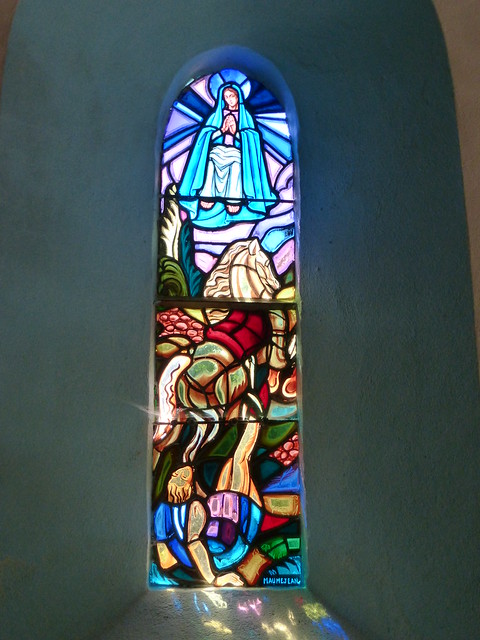 The third one depicts the apparition of the Virgin to the knight who built the chapel in Vesly.
The third one depicts the apparition of the Virgin to the knight who built the chapel in Vesly.  The fourth one depicts the Virgin blessing the mission of Father John Eudes to Vesly.
The fourth one depicts the Virgin blessing the mission of Father John Eudes to Vesly. 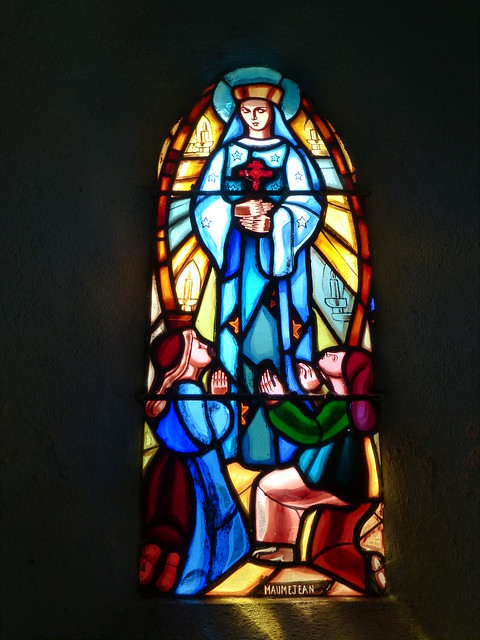 The fifth depicts the Virgin appearing to children in Pontmain.
The fifth depicts the Virgin appearing to children in Pontmain. 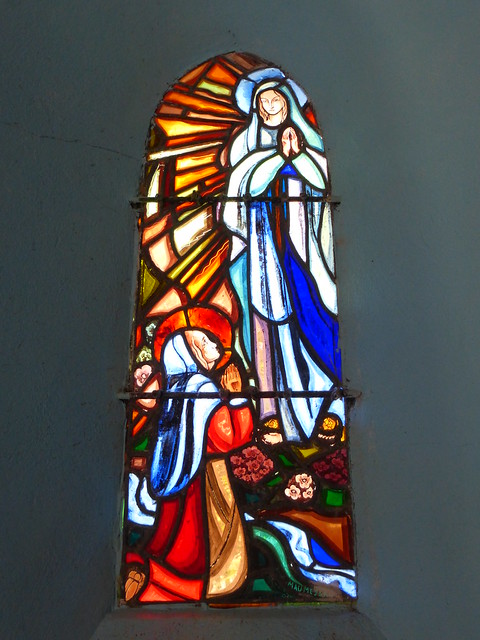 The sixth window depicts the apparition of the Immaculate Conception to Bernadette Soubirous at Lourdes.
The sixth window depicts the apparition of the Immaculate Conception to Bernadette Soubirous at Lourdes.